Buongiorno di Milano, amori! After all the glorious collections from some of fashion’s most buzzy names at NYFW and LFW the past two weeks, we now head to watch the latest shows from some of the fashion world’s MVPs. So what’s there to be excited for this season? Well, there is of course Raf and Miuccia’s next collection for Prada, their first womenswear offering since Raf closed his namesake label. There’s also a new collection from Matthieu Blazy at Bottega Veneta and Maximilian Davis’s sophomore collection at Ferragamo that are bound to leave us giddy, as well as the first womenswear line from Gucci post the departure of Alessandro Michele, and likely their last studio-led season before a Sabato de Sarno takes over as creative director. Here’s our breakdown of everything you need to know from Milan Fashion Week AW23.
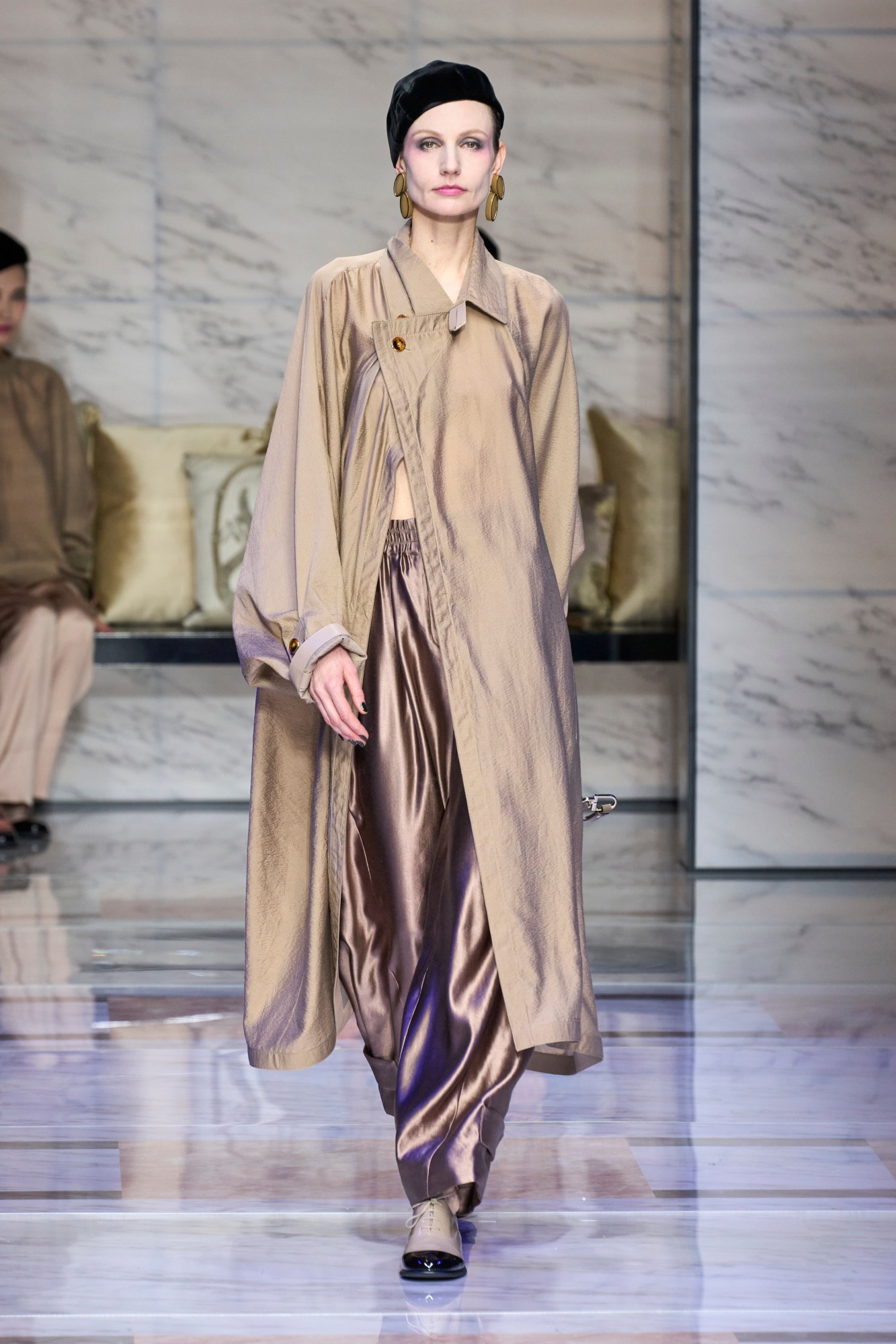
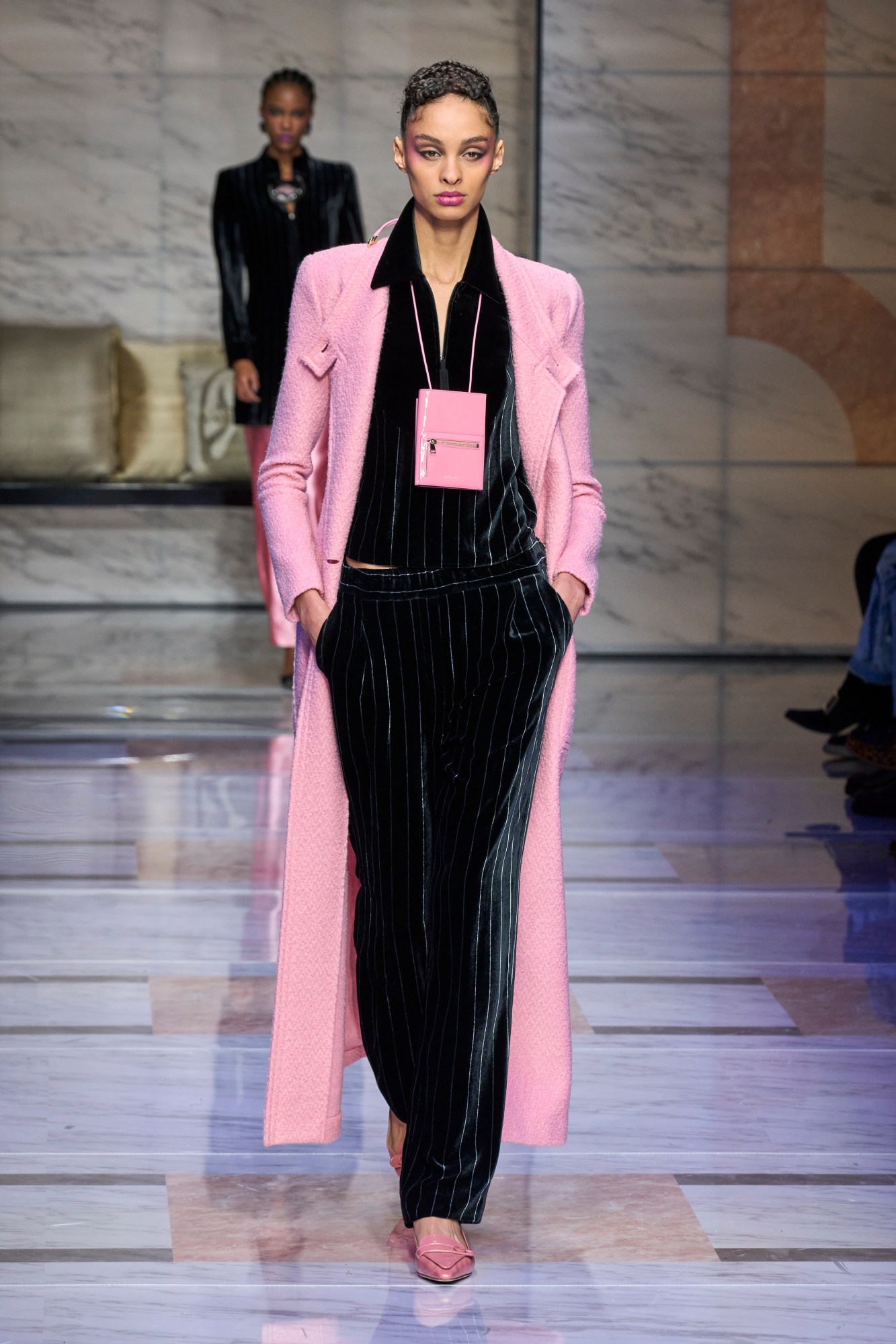
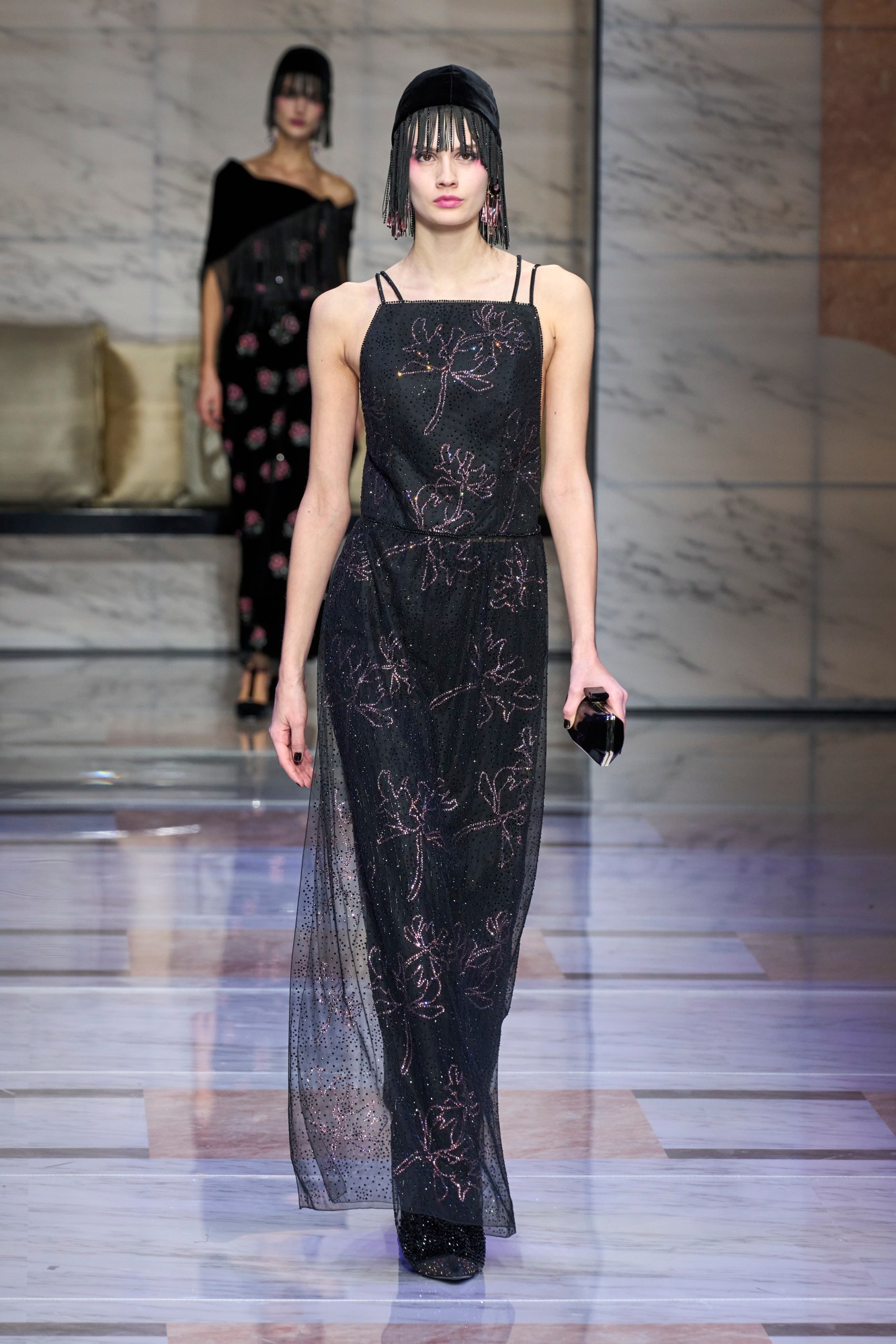
Giorgio Armani
It would appear that show attendees are not the only ones beginning to grow weary of the bombastic, gimmick-centred spectacles that have become par for the course at fashion weeks of late. There’s also been a notable shift among brands, too, with designers including Raf and Mrs P at Prada, Jonathan Anderson at Loewe and – as his recent Vogue interview about the house’s forthcoming show would seem to suggest – Demna at Balenciaga all choosing to dial back on the event production to focus on what ultimately keeps fashion’s cogs turning: the clothes. Though he’s never been one for the sort of Instagram-targetted stunts we now see so regularly, joining this coterie of creative directors this season was one of the industry’s all-time greats – Giorgio Armani – who invited his audience into a cosy setting at his namesake house’s headquarters to present “an enveloping and personal vision that suggests intimacy as an antidote to a moment of theatrical excess,” the show notes read.
In a cushion-lined theatre salon, the esteemed designer explored the notion of maquillage – or doing your make-up, basically – unpacking the intimate ritual of getting dolled in the sacred privacy of a room of one’s own. Hammered silk kaftan-coats and wide, liquid satin trousers were lounge-ready, appearing in the shimmering colours of an earthen-hued eyeshadow palette. Négligée slips came in foundation-y hues of alabaster, tawny beige and cocoa, buoyed by the pouffiness of furry gilets and thick-pile shawls. The designer’s signature long-lined, languid tailoring naturally figures, with louche suiting in matte grey felted wool and floor-skimming, square-shouldered coats in blush bouclé, while a slender evening dress in pink-satin-lined black velvet with a diaphanous bustier – and a delicately embroidered camisole gown – exuded both red-carpet-ready showmanship and the smoky sensuality of the dressing room. MS
Bottega Veneta
There’s a fun game you can play at a Bottega Veneta show. It’s inspired by the TV show Is it Cake?, but instead you have to ask: Is it Leather? Honestly, it’s hard to tell. You can only really find out if you get up close enough to touch the pieces on show. The knitted socks and striped pyjamas by bed-headed models at the start of the show? The cosy turtlenecks, elegant peignoirs and buttoned-up Monday morning tailoring? Yes, it’s all leather. Trench coats, tank tops, more denim, embossed-floral skirts, sprezzatura layers of four-pocket shirts, slouchy tailoring and ties; bucket bags, socks, thigh-high boots, woven sandals that you might find at the beach; even paillette sequins. It’s all leather! Not only that, but it’s the best leather in the world, treated with so much care and technique that it’s weightless and unrecognisable. On a practical level, it’s also incredibly comfortable (I wore a pair of last season’s leather blue jeans that day, and honestly forgot they weren’t denim until I had to stomp across town; I didn’t need a coat). Read the full review here. OA
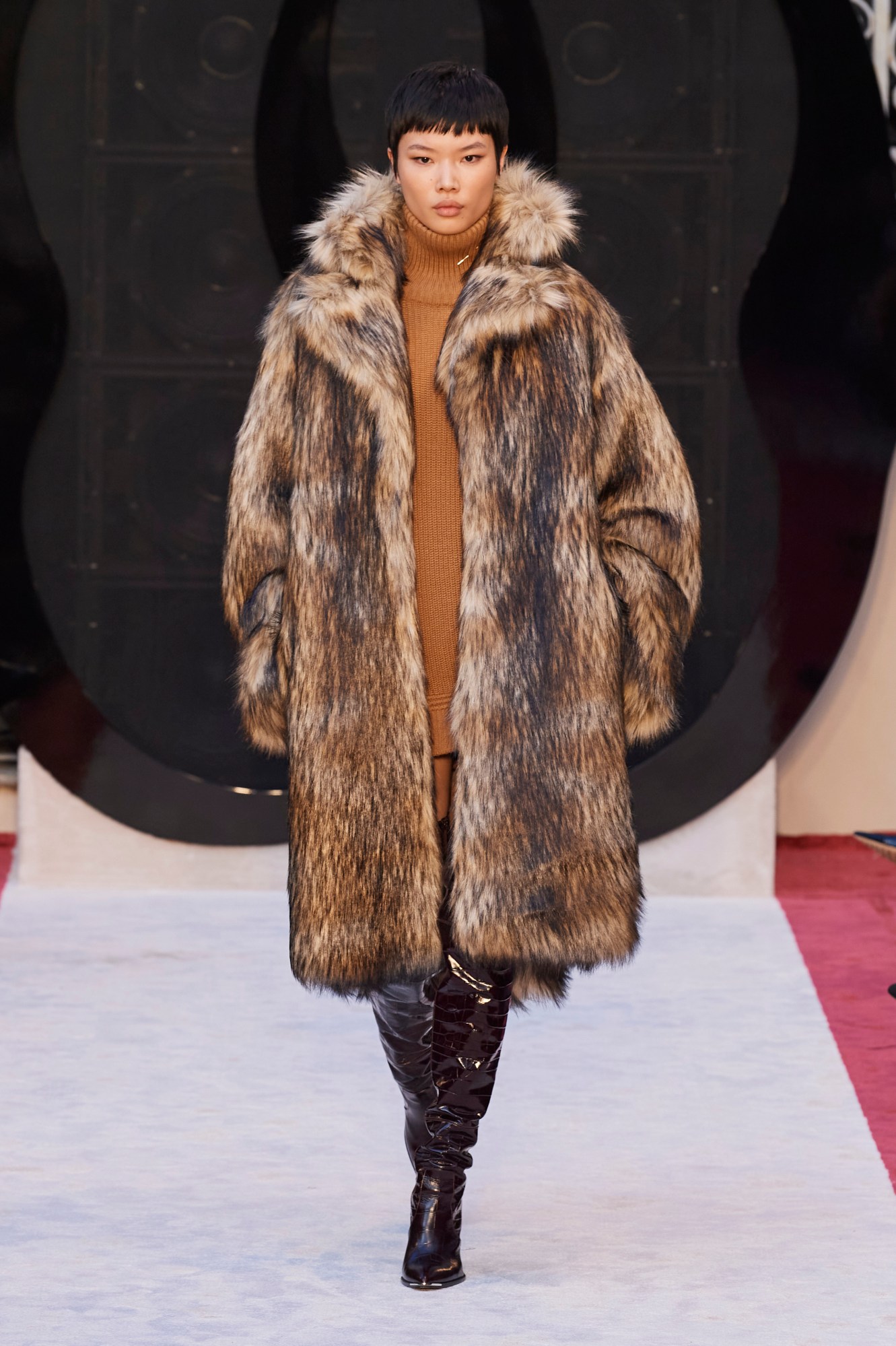
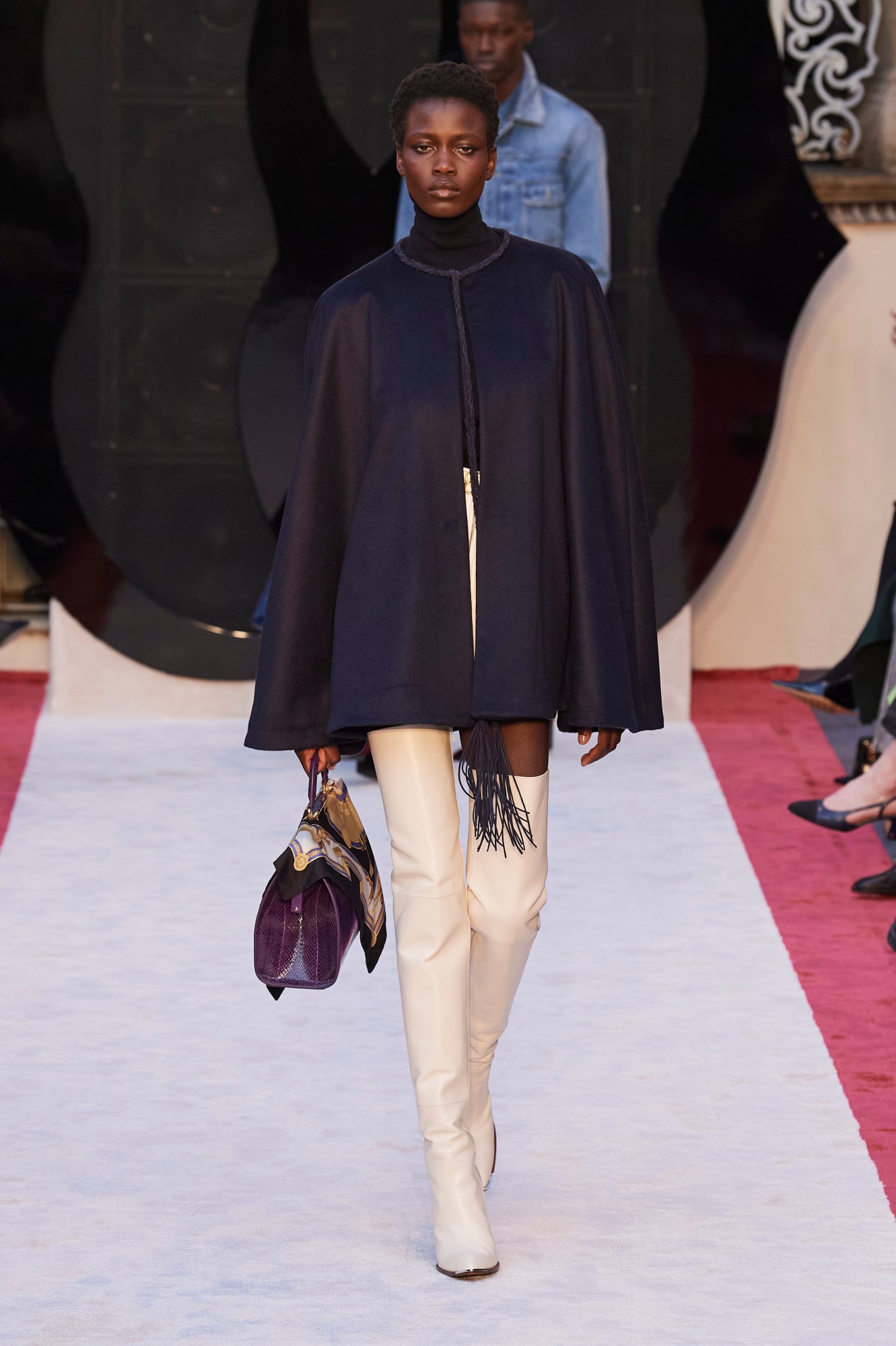

Bally
For his sophomore collection for Swiss fashion house Bally, Angeleno designer Rhuigi Villaseñor contemplated a rather existential theme – the Persistence of Time. On first reading the collection’s title, you’d be forgiven for either expecting a sombre meditation on how, as Madonna famously sang, time goes by so slowly, or a surrealist sartorial tableau – an homage of sorts to Salvador Dalí, the artist behind the similarly-titled, world-renowned painting.
Those expectations were, however, confounded, with the designer choosing to investigate themes of timeless glamour, and how the notion shifts across time and place. Looking in particular to glitz and razzle dazzle of his hometown, LA, and the more sober elegance associated with Bally’s home country, Rhuigi spliced together looks and motifs that spoke to both ends of the spectrum. Sculpted tweed blazers worn with slim wool trousers and riding boots appeared next to billowing foulard-print silk separates. Edgy, button-down black leather dresses with thigh high boots and louche, red-carpet-ready tawny velvet suiting complemented the prim chic of sharp primrose shirting styled with a cork-hued high-waisted corduroy skirt, and the alpine glamour of hulking furs. All in all, this was a collection that paid homage to fashion archetypes that have stood the test of time, but proved Rhuigi to be a designer keen on casting them anew for those that look back on them later down the line. MS
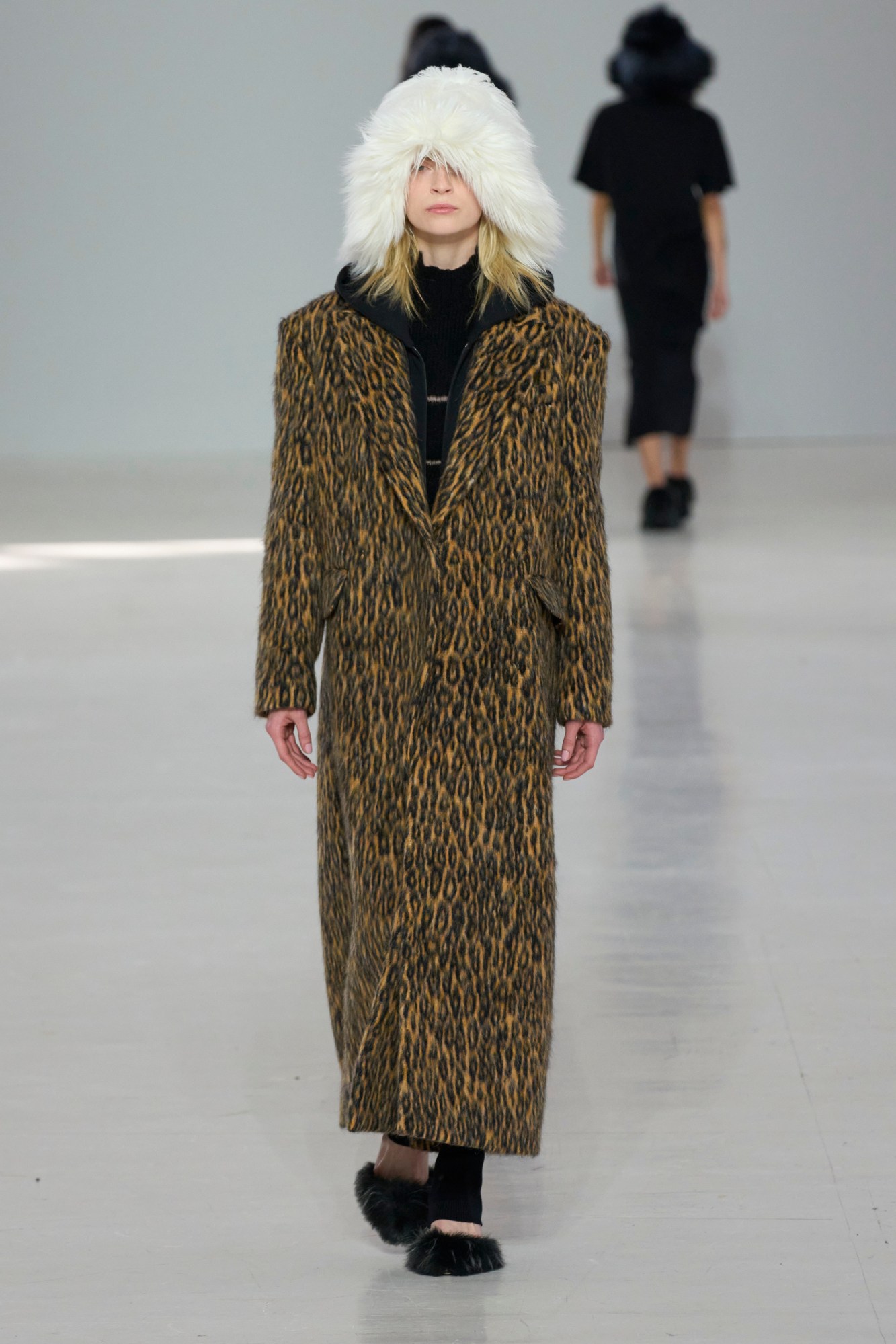
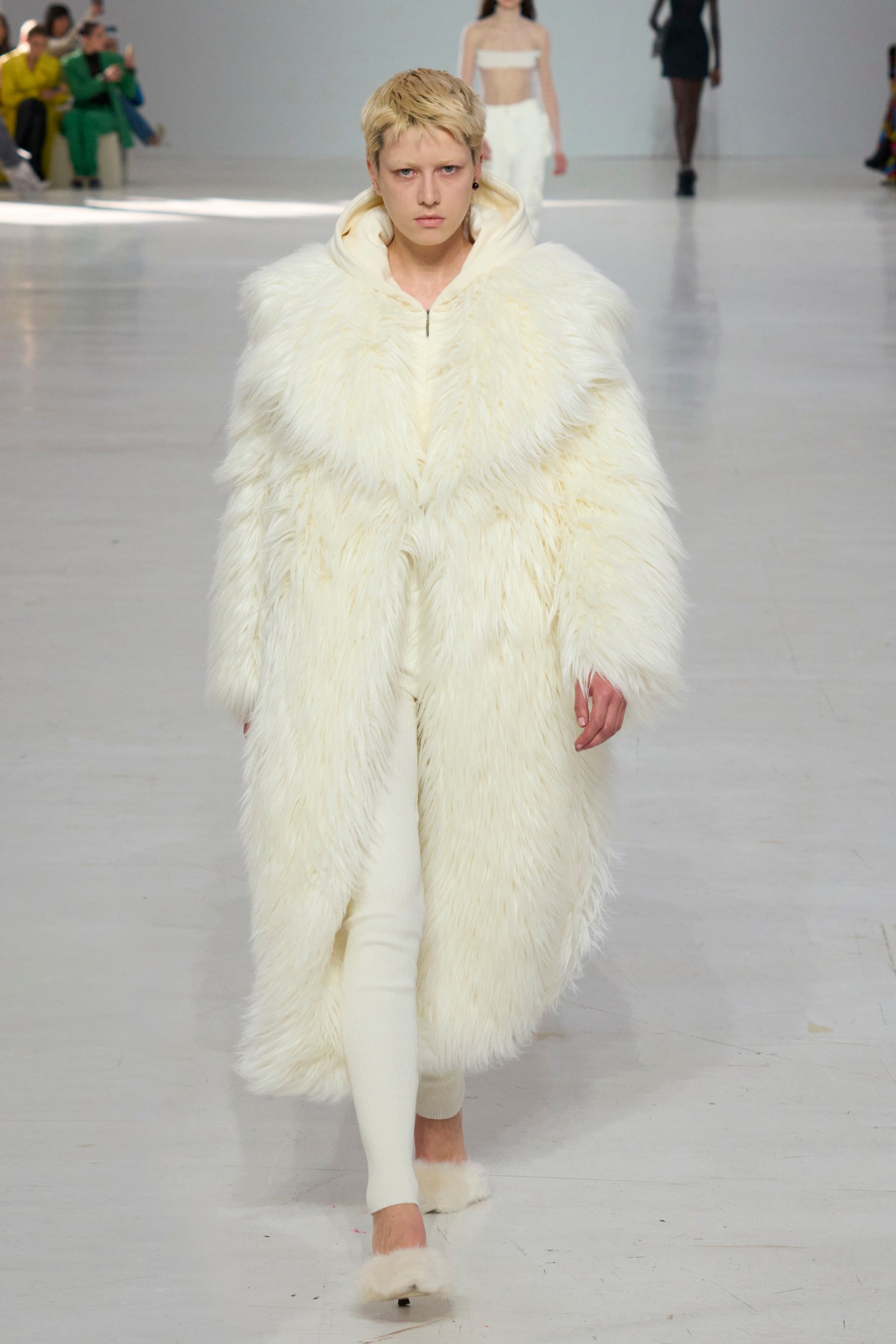
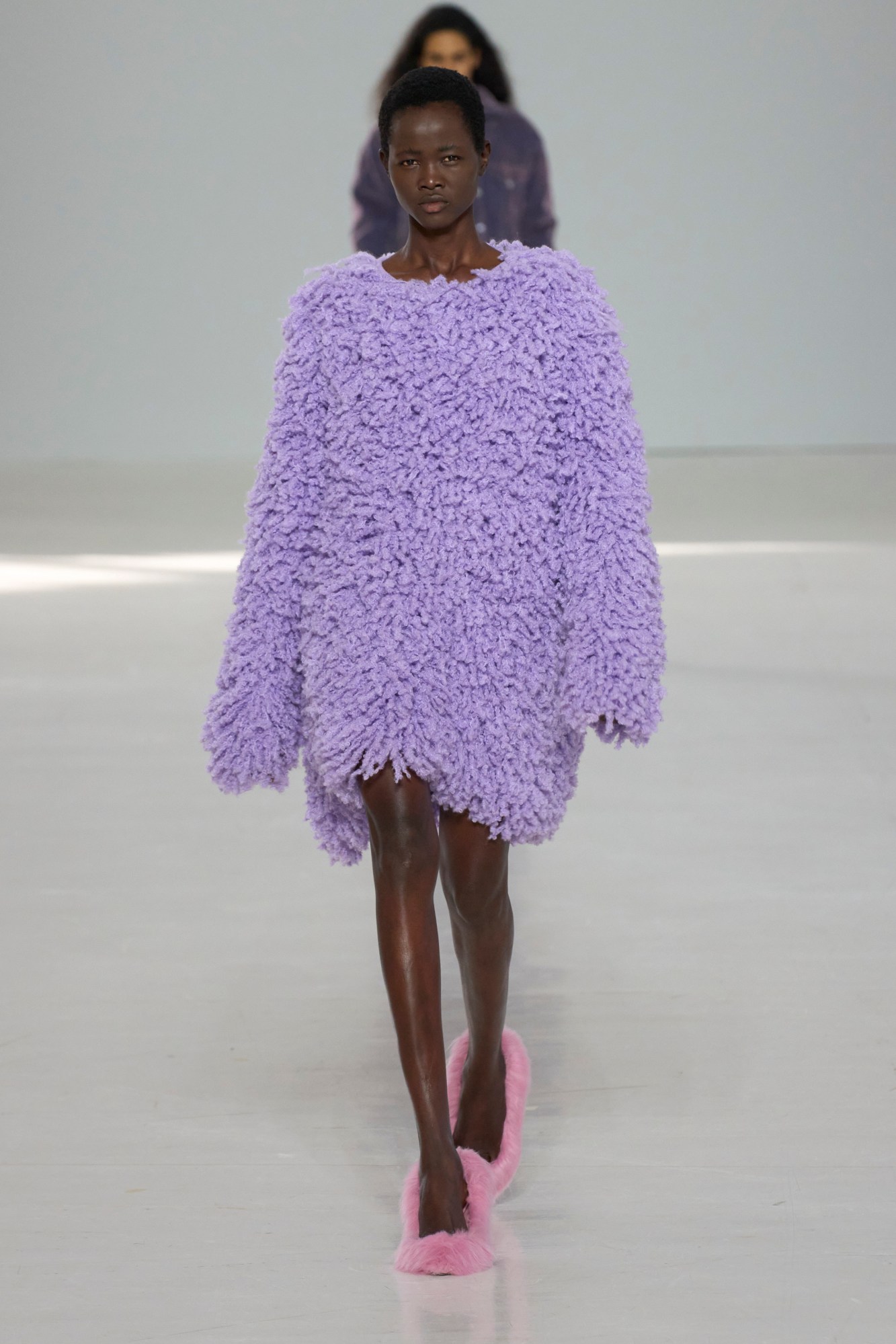
MSGM
This season in Milan, designers seem to be doing away with oblique moodboards and gimmicky referential frameworks for their collections. It’s as if the city’s creative teams have collectively resigned from the job of justifying their work with high-minded, though ultimately hollow, concepts – they’ve diverted their attention way from inventing emperor’s new clothes through language, and retrained their focus on making convincing, believable garments in cloth. The latest to do so was Massimo Giorgetti of MSGM, who took to a cavernous white hall – a figurative and literal carte blanche – to present a collection that gave off a sense of immanent wearability and practicality.
Rather than become embroiled in the impossible task of creating clothes that comment on – or, more naively, attempt to mediate – the current sociopolitical climate, he offered quietly inventive riffs on familiar garments that we all like to wear. Tailored jackets came with imposing boulder shoulders, and shaggy faux fur coats had cartoonishly swollen lapels. The home-y casualness of graphic band tees and oversized knit sweaters, insouciantly hanging off a single shoulder, was counterposed by the mock sincerity of striped poplin blouses with tied details, and elongated herringbone tweed blazers styled as dresses. Flashes of florals, velvety silver and lurid florals, as well as sea anemone knits in fuchsia and mauve, brought a sense of levity to the mix – their deployment, however, was less a case of offering optimism at a time when it’s needed most, and a more a matter of presenting colours, textures and motifs that – put plainly – are nice to look at and touch. At a time when the world furnishes us with so much to think about, this was a collection that reminded us that fashion is often at its best when it offers respite from that. ‘No thoughts, just vibes’ fashion, if you will – and fab vibes at that. MS
Ferragamo
At the seasonal shows taking place in New York, London, Milan and Paris, there’s been a lot of chatter on the front row about the snowballing scale of fashion shows. The crowds of screaming fans outside them probably couldn’t care less about what’s coming down the catwalk, which in far too many cases feels gimmicky: clickbait clothes that are desperate to go viral. Designers are feeling it, too. Miuccia Prada and Raf Simons have been going on about reduction and simplicity, celebrating everyday uniforms in their most recent collections. Matthieu Blazy has been using the phrase ‘perverse banality’ to describe his unassuming, casual archetypes in trompe l’oeil leather. Jonathan Anderson has been dialling back his Loewe shows to essentials. And of course, soon we will see the return of Phoebe Philo, the woman who reshaped the look of fashion in the midst of the last double-dip recession and influenced a generation with her clean, logoless aesthetic.
It might sound silly to say that designers are making clothes again — instead, it feels like they’re focusing on simple, intelligent and precision-cut clothes. It feels prescient, too; in the real world, a socioeconomic storm is brewing, inflation is at an all-time high and fashion is gearing up for tough times.
It all comes back to one word that has been absent in fashion parlance for quite some time: Minimalism. Remember her? While most young’uns might be too young to remember the clean, architectural lines of Jil Sander and Calvin Klein, the idea of clean-lined silhouettes and hyper-focused clothes, antidotes to the logomania and bling-bling ostentation of the last few years, has been gathering momentum. Yesterday morning, in a vast, futuristic space in central Milan, Ferragamo’s 27-year-old creative director Maximilian Davis cemented the return of the M-word with his sophomore collection for the house. As far as fashion shows go, it offered purity and elegance, and a lot of classics. It also proved that less really is more when it comes to wanting to look very expensive. Head here for the full review.

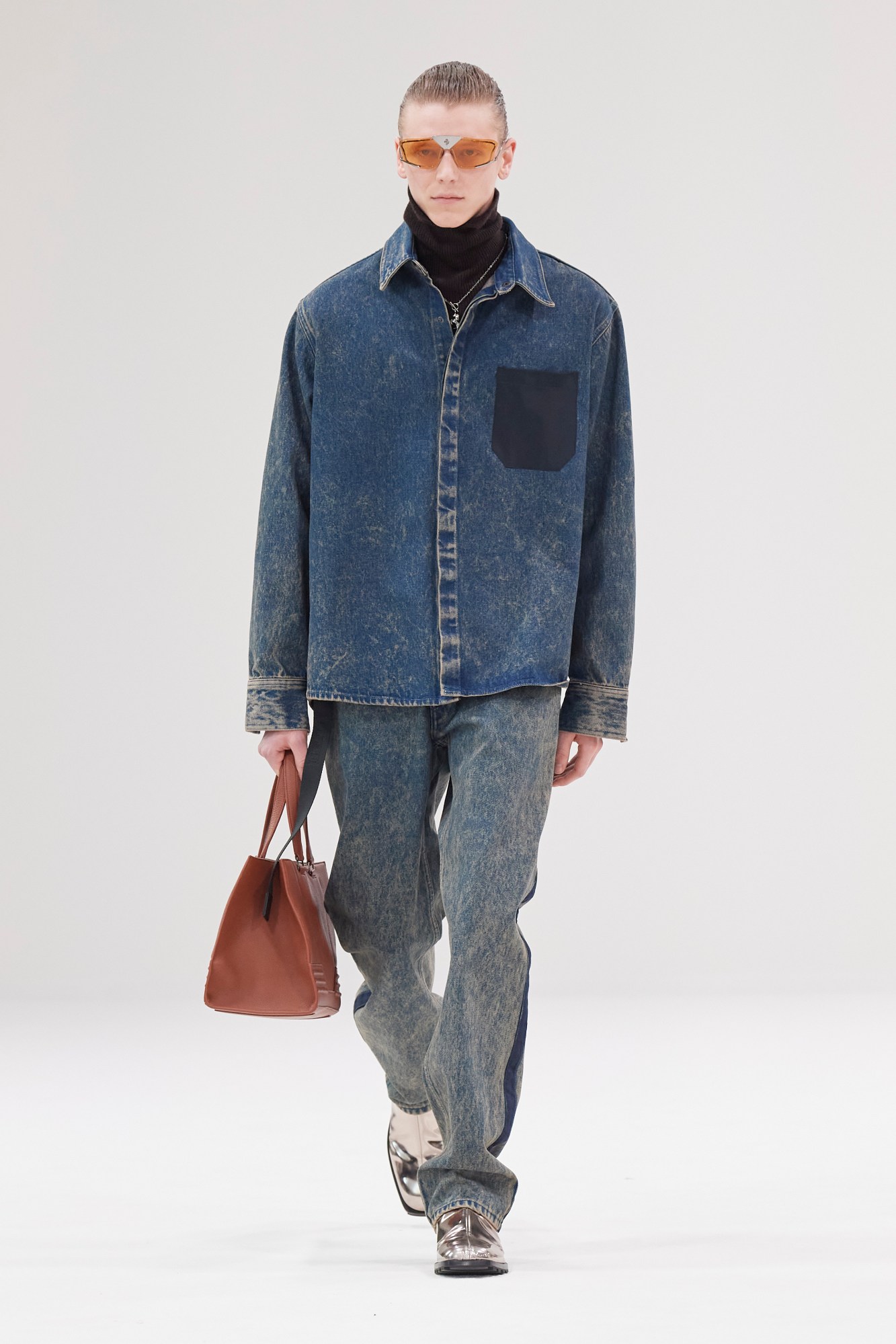
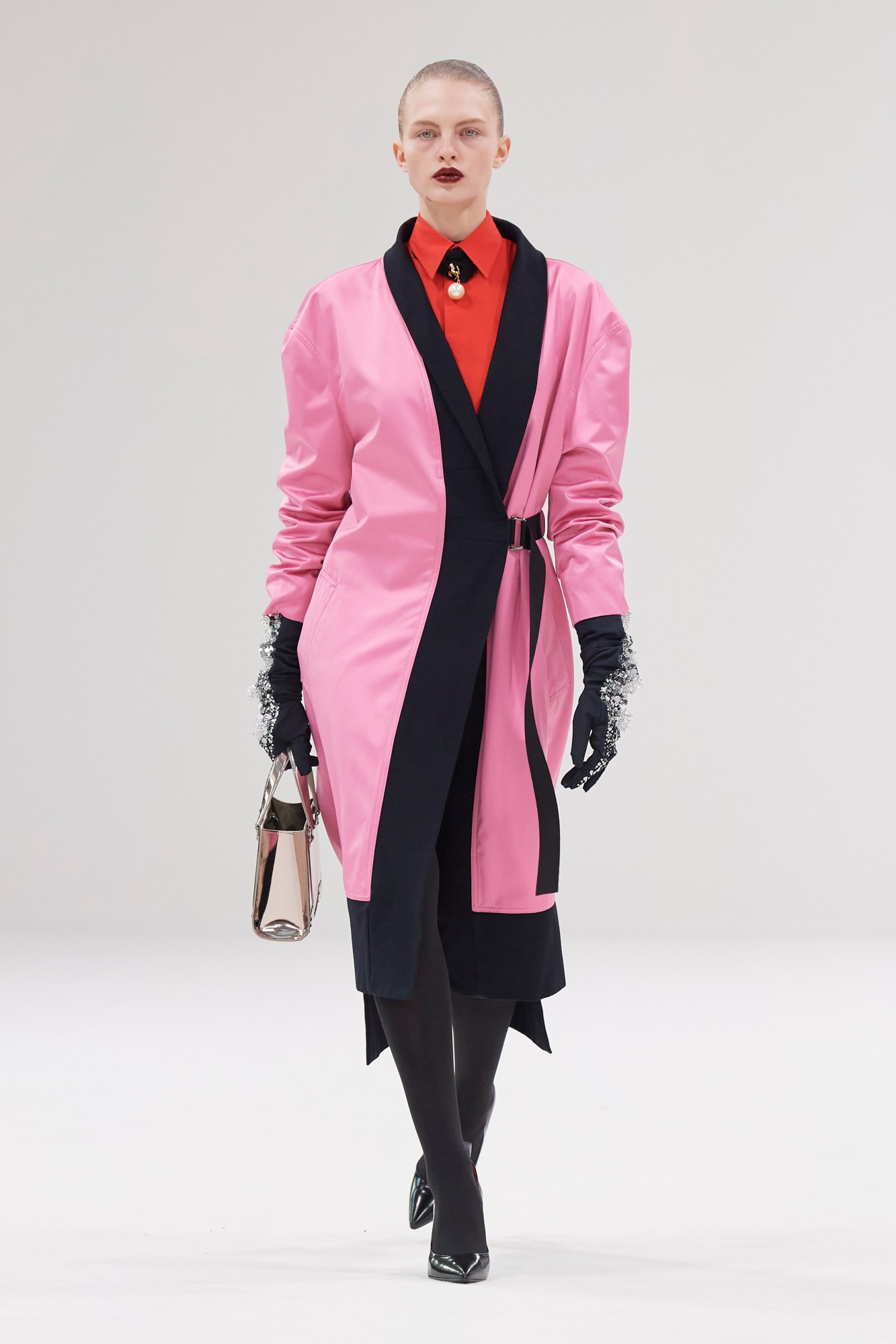
Ferrari
For their fourth collection, Rocco Iannone – the creative director of the fashion arm of the Maranello-based sports car giant – looked to the beauty within movement, speed and acceleration as inspiration. Mostly cast in dark grey hues, high-waisted trousers sat over a waistband of the same trousers creating a sense of movement akin to a 20th-century Futurist painting, while gradient-toned gowns embroidered with the brand’s logo trailed with fringe. Cropped jackets and oversized curved trousers were made from quilted padded materials, the latter’s legs swishing like wings with every step. Trench coats and suit trousers, some worn by supermodel Irina Shayk, were sharp and aerodynamic, with silky red interior lining, while soft, rich green and crimson knits were styled with shirts beneath. Workwear was paired with tailoring, too, with jumpsuits featuring asymmetrical zippers and oversized lapels, vibrant block colour leggings coming with patches of ribbing, and a matching fitted crop top paired with puffy gloves. Elsewhere, denims were spray painted with the same techniques used to paint the body of a car, and looks werre strapped onto the body with safety buckle belts, resulting in dramatically cinched silhouettes. These were sexy, sleek and dynamic clothes as sexy, sleek and dynamic as the cars Ferrari known for the world over. TG
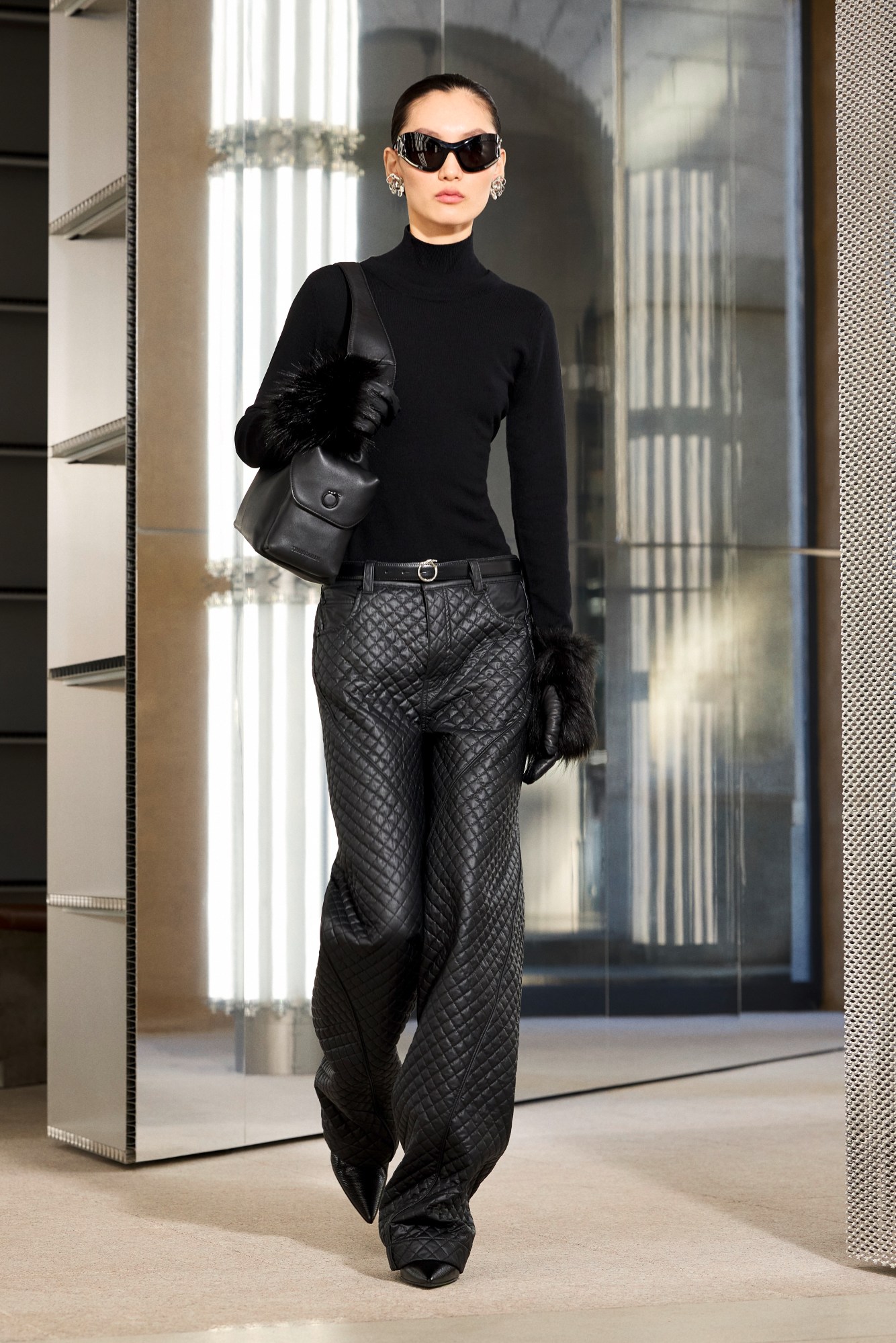

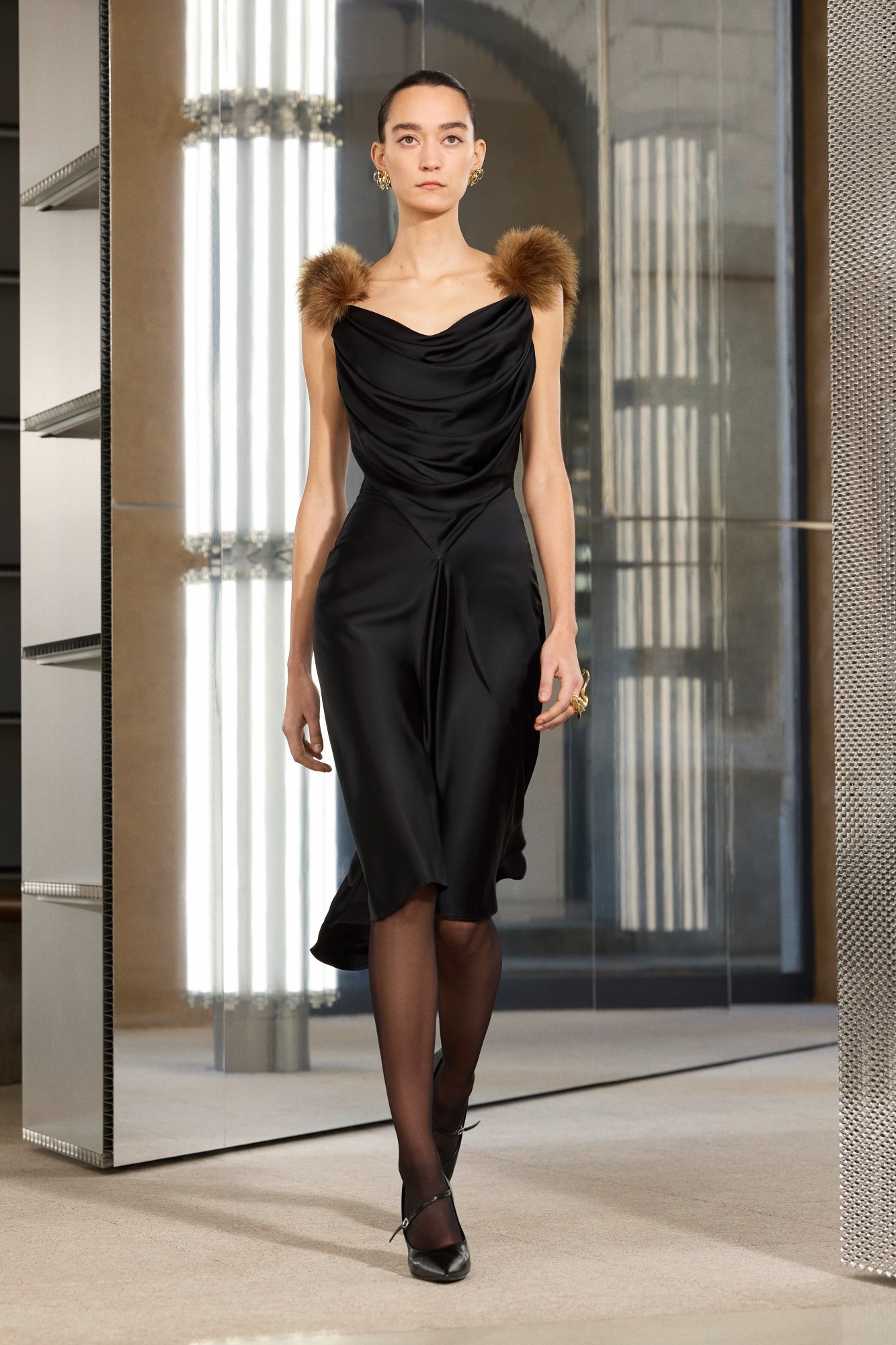
Trussardi
Looking at their most recent collection for Trussardi, the Milanese house they took the helm of a year ago to date, Benjamin Huseby and Serhat Isik have been spending a good amount of time observing the characters that leisurely pace the tony streets around the brand’s newly opened flagship store. Located smack bang in the heart of the chicest part of Milan, it’s the time-honoured stomping ground of one of the city’s quintessential style icons – the sciura, the fur-swaddled, blacked-out shades-wearing lady of leisure whose order of the day typically comprises a tour of the shops and a lunch of salad, wine and gossip with her fellow sciure friends.
Rather than simply create a wardrobe for a woman already well-catered to by plenty of Trussardi’s neighbour, Benjamin and Serhat sought to draw upon the elegant codes of her wardrobe and expand their remit – essentially democratising access to an elitist set of sartorial cues to all. Tapestries found in crumbling palazzos served as point of departure for a boxy men’s harrington, a coat dress and a leatherette trimmed wrap-skirt crafted from intricate Gobelin jacquard featuring depictions of italian greyhounds. Straight-leg trousers cames in sumptuous matelassé faux leather, and a whittle-waisted coats was cut from thick écru wool, with both pieces conveying an air of elegant severity. Flashes of campy eccentricity came with a full-length hazelnut faux fur coat – a must for any sciura worth her last name – sported here by a male model, while a racy sensuality perhaps more fitting for a grande dame’s granddaughter informed flounced mauve duchess satin miniskirts and dresses with twisted necklines, with a similar dress silhouetted in a coated black fabric featuring a scanty beaded bust. Clothes that any sciura – authentic, aspirational or otherwise – would be no doubt beproud to wear. MS
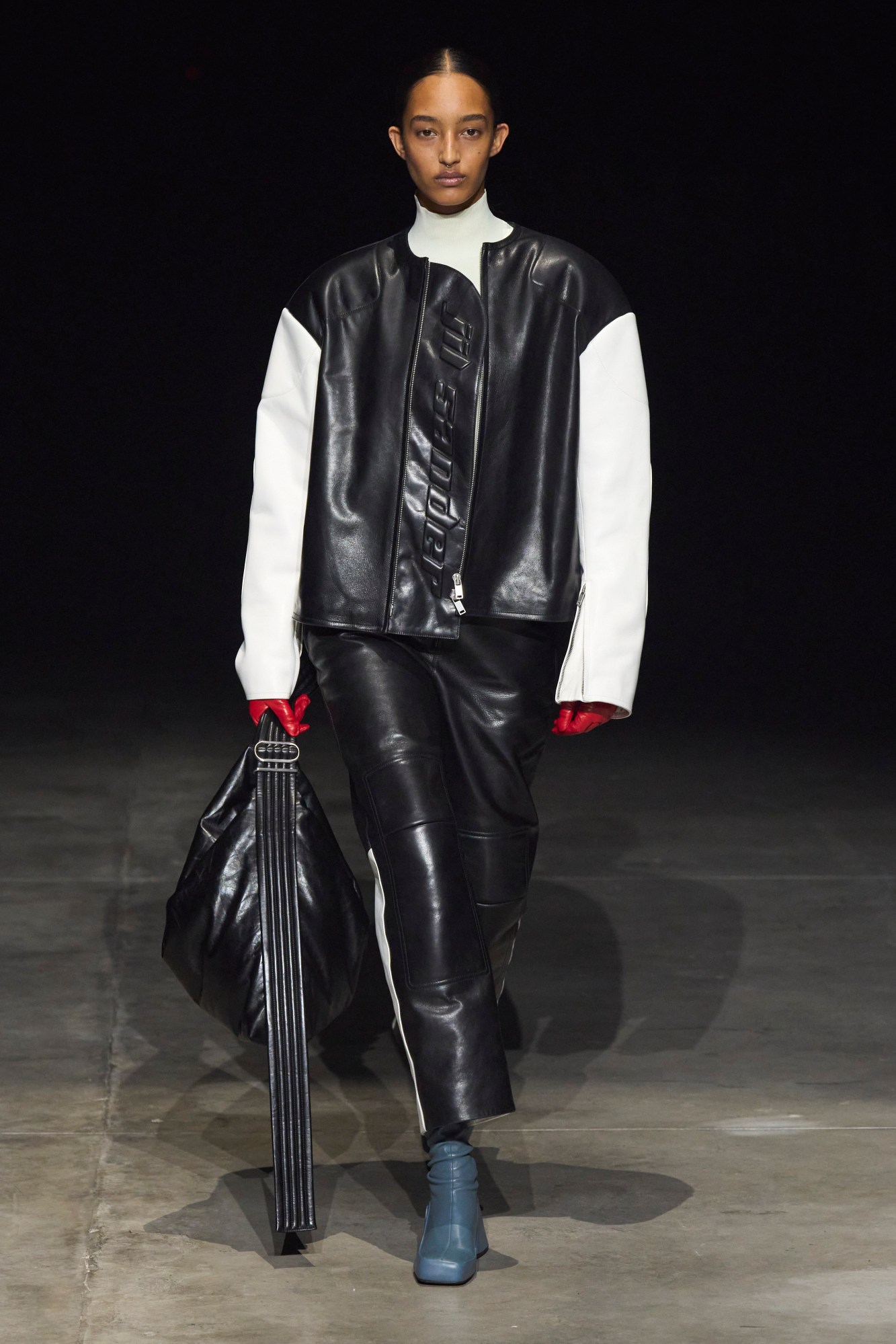

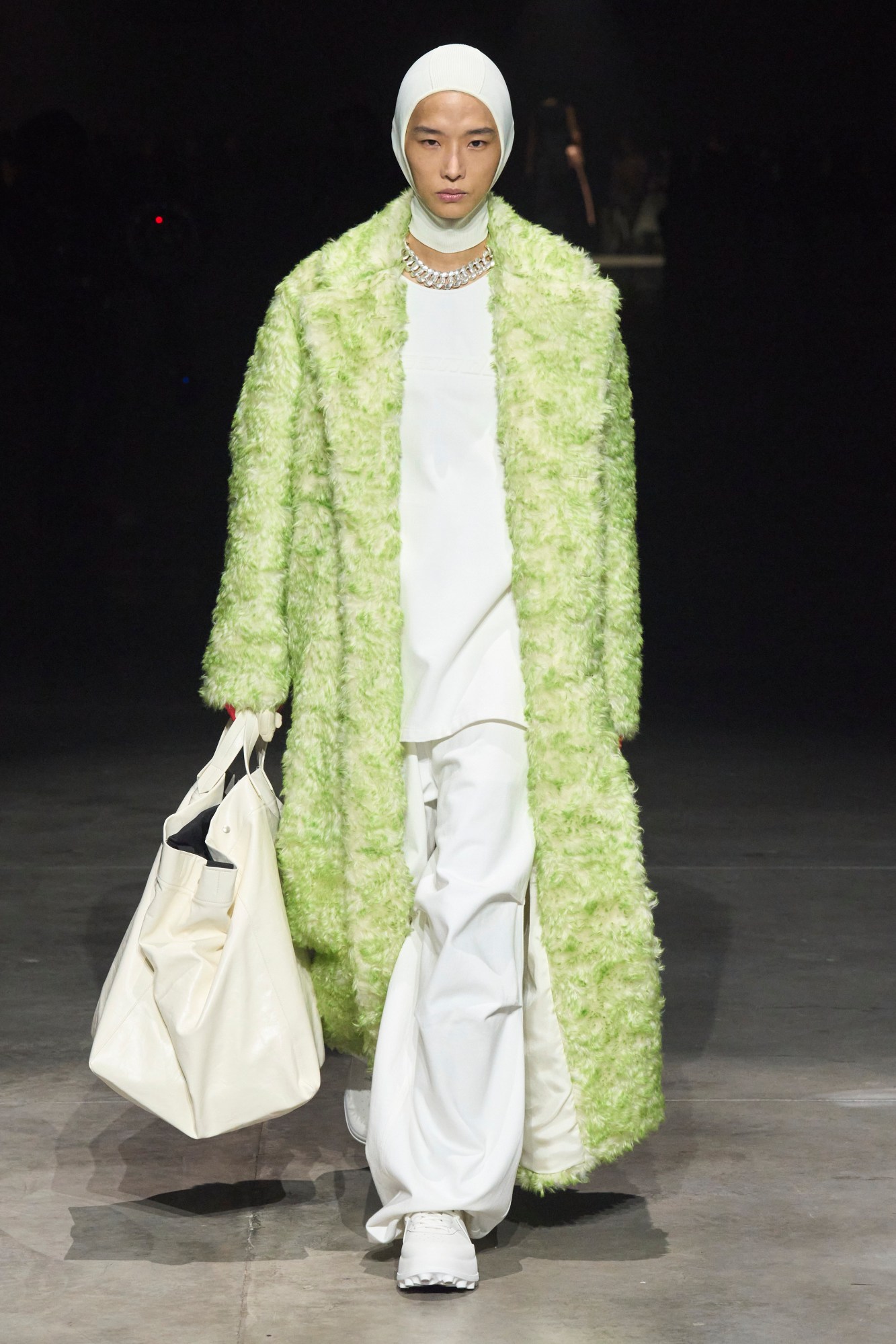
Jil Sander
Jil Sander is not a house known for its eclecticism – rather, the majority of its loyal acolytes have been drawn to the brand for clothes that exude a sense discreet yet painstakingly crafted luxury; clothes that are the sort of IYKYK flex you see being worn of accomplished clients of understated yet impeccable taste, often paired with brands like Phoebe Philo-era Céline, Khaite and The Row. Since taking up the helm of the house, this is an approach that Lucie and Luke Meier have more or less stuck to, creating collections that generally adhere to an ethos of cerebral minimalism, albeit with a greater diversity of textures and embellishments than had been seen under previous tenures. This season, however, saw the pair bring a fresh – and perhaps rather unexpected – jolt of energy to the brand, resulting in perhaps the most varied, poppiest Jil Sander collections in recent memory.
Biker jackets and panelled trousers in buttery leather came in contrasting block hues of white, black and royal blue, with the jackets featuring an embossed logo in racer game graphics on zipper-concealed inner flap. Sleeveless collar dresses came in textures spanning silver tinsel knit and fluid zebra stripe silk jersey crepe, while full-length shearling coats were tufted lime green. Of course, this being Jil Sander, there were plenty of easier-wearing looks – paper doll-cut, sculptural tops and amply cut suiting in crisp Italian wool, for example – that will be dropped straight into the baskets of its pre-existing clientele as part of next season’s uniform. The impression one was left with on seeing after seeing this collection, though, was of a consciousness on Lucie and Luke’s part to create more extroverted clothes that appeal beyond it – while we’ll only know if that objective has been achieved in a couple months time, we’d be glad to wager that it will be. MS
Gucci
Review to follow.

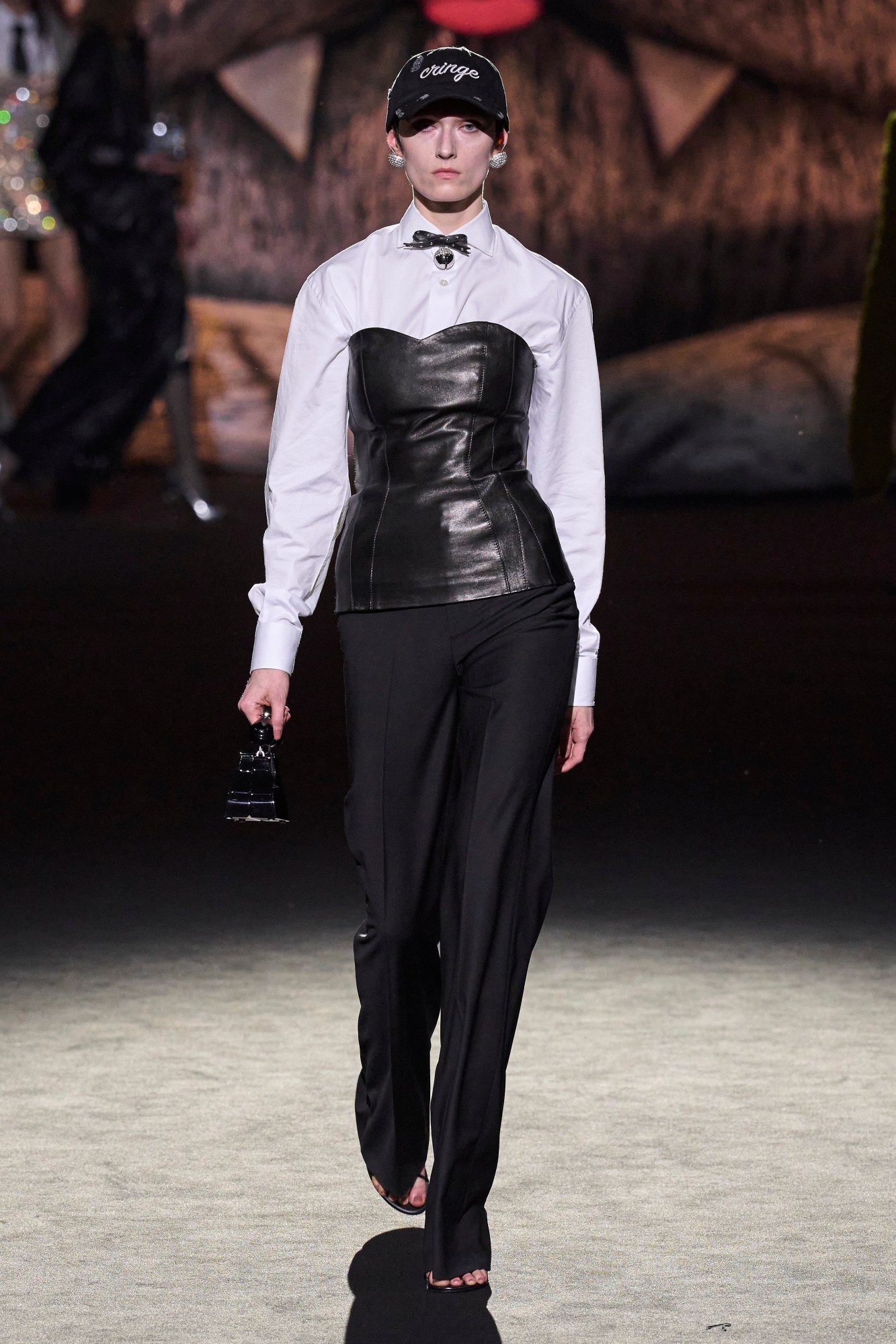
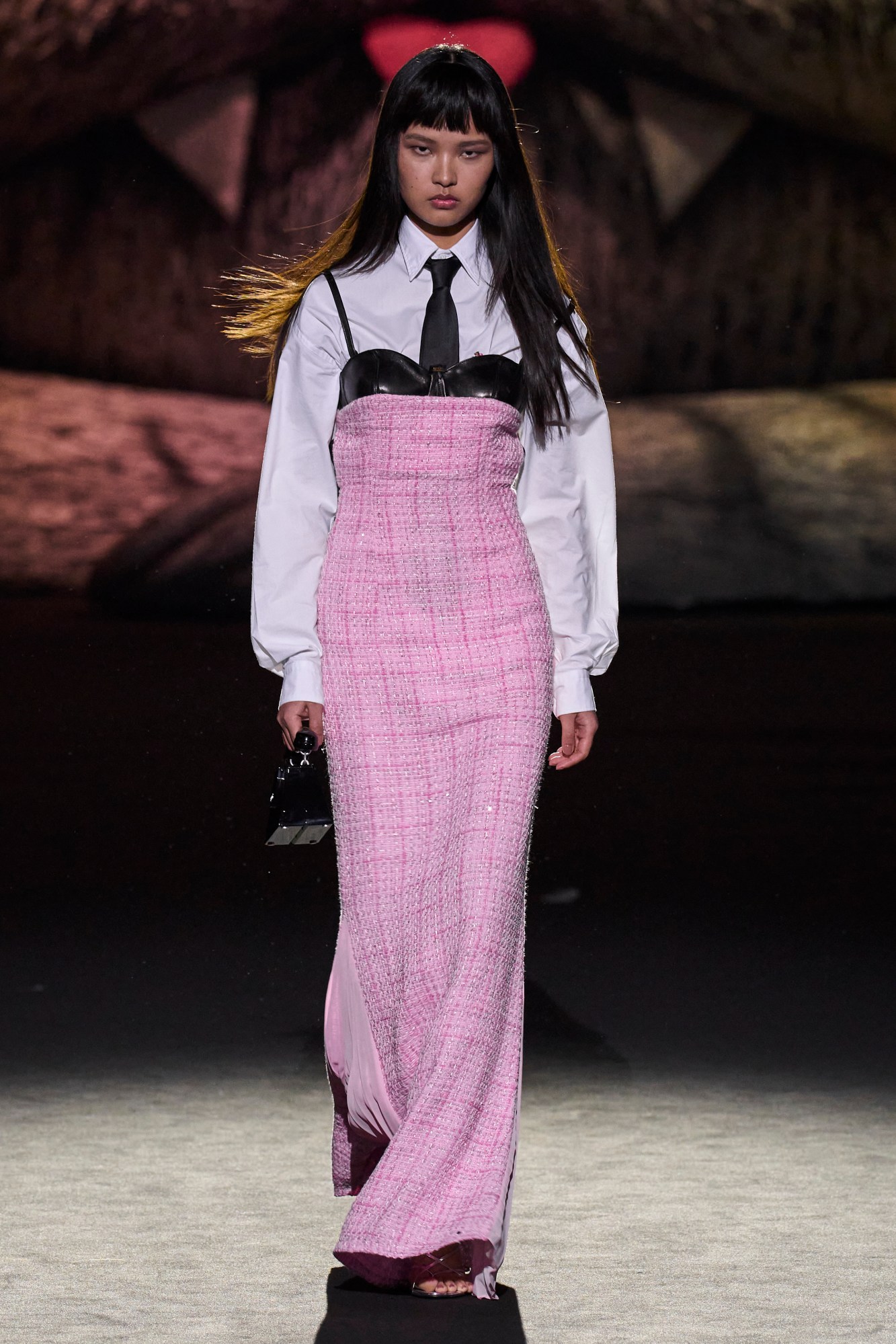
GCDS
This season has seen the emergence of a curious trend for humdrum animals – or their depictions, rather – appearing on the catwalks. We’ve seen pig prosthetics at Collina Strada, frog wellies at JW Anderson, chicklet prints at Christopher… naturally, here in Milano, we’ve been keeping an eye out for who would be carrying on the trend, and last night, the honours went to GCDS. Rather than put depictions of furry friends on clothes, though, Giuliano Calza, the label’s founder and creative director, opted to place a gigantic representation of his cat Kittho on the runway.
Granted, this was a rather different example of fauna taking over fashion shows to what we’ve seen so far. Save for a few tiger patterns in shimmering lurex and wasp-stripe sequins, feline features were few and far between. Giuliano’s intention with the eye-catching staging device was, however, to offer a prism through which to view the collection itself – to “reduce the distance between his perceived public persona, and who he really is”, a release read, using the gigantic sculpture of his cat as a figurative means to invite the audience into the intimacy of his own home. This achieved, Giuliano allowed himself free reign to create a collection that unabashedly embodied what impassions him most in his chosen métier. Campy marigold yellow gowns crafted from ballooning drapes of duchess satin; boxy, bourgeois tweed tailoring rendered in bubblegum pink; borderline-gothy sharp-shouldered, long-lined leather coats with frilled hems; poplin shirts with bright bathmat tufts. Rather than a superficially imposed narrative, this was a collection that revelled in the things that would appeal to any human being with a tactile sensibility – and probably to any cat, too. MS
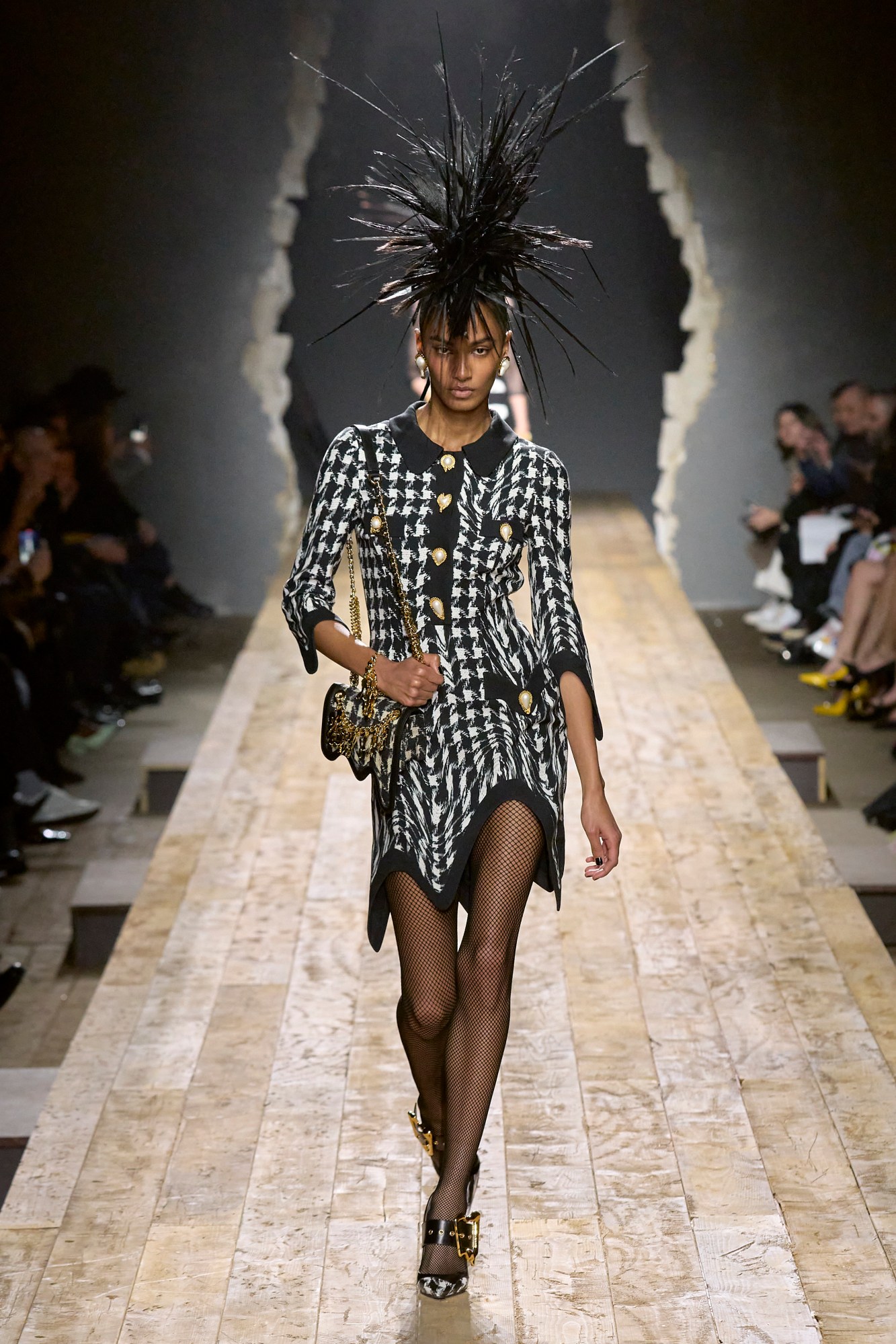
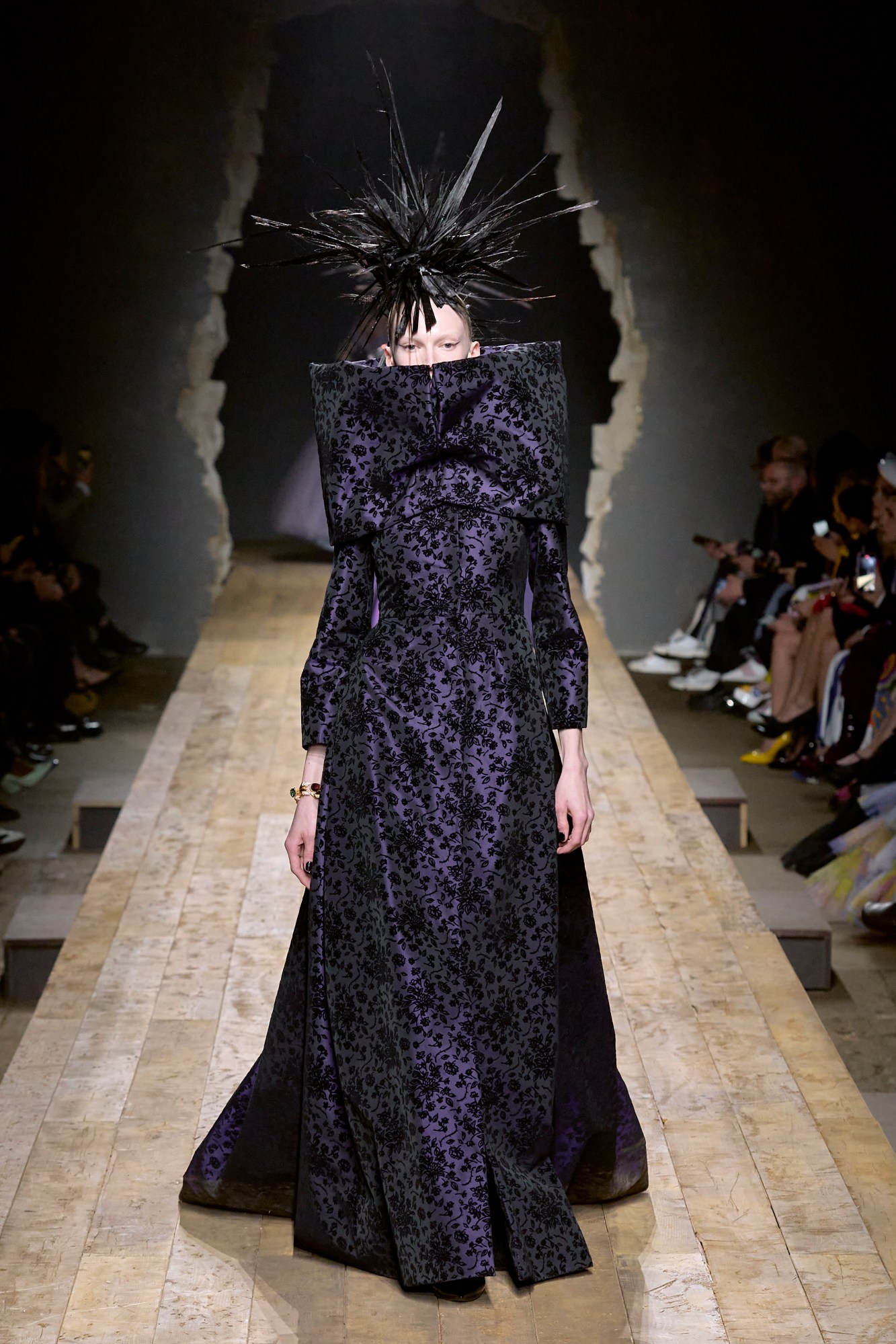

Moschino
In fashion parlance, classics are meant to stand the test of time. The “investment pieces” that are heralded as timeless style are revisited again and again by big houses in seasonal fashion collections. Which is why Moschino’s Jeremy Scott decided this season to melt them all down, poking fun at the mythology that fashion is forever. Monochromatic bouclé suits, black leather jackets, LBDs, buckled hardware, floral jacquards — essentially, the perennial archetypes of fashion recognised by anyone and everyone — were melted into drippy silhouettes, as if they were clocks in a Dalí painting.
“I was inspired by Salvador Dalí and when he was talking about the persistence of memory, seeing Camembert melting in the sun and how he took that and made the clocks melt in his paintings, the relativity of time and how it can be elastic,” explained Jeremy after the show. “Sometimes it feels very sped up, sometimes it feels very slow. I wanted to take the classics and melt them and distort them.”
Part of Jeremy’s success is that his concepts are so easily understood, worn on the sleeve in a way that feels both sincere and understandable. Most importantly, it’s fabulously fun — you can imagine a whole new generation wanting to wear a typically fusty tweed suit when it comes with melted gold jewellery and witty, cartoonish silhouettes. Elsewhere in the collection, an aristo-punk paradox offered a harder counterpoint to the molten details through the glass-shard mohawks and lashings of what he described as “Crown Jewels”. Splendour fit for a queen from fashion’s king of kitsch. OA
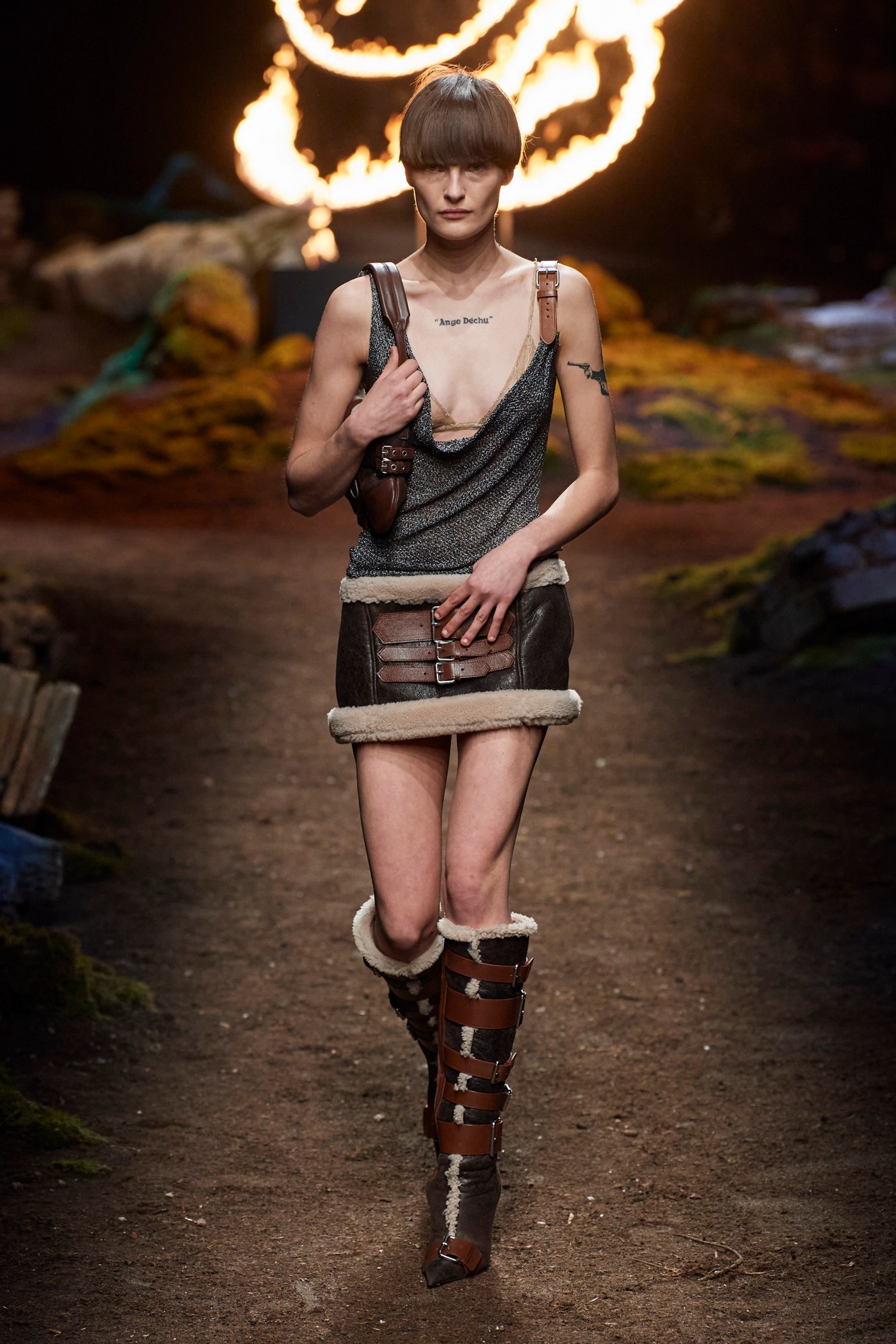
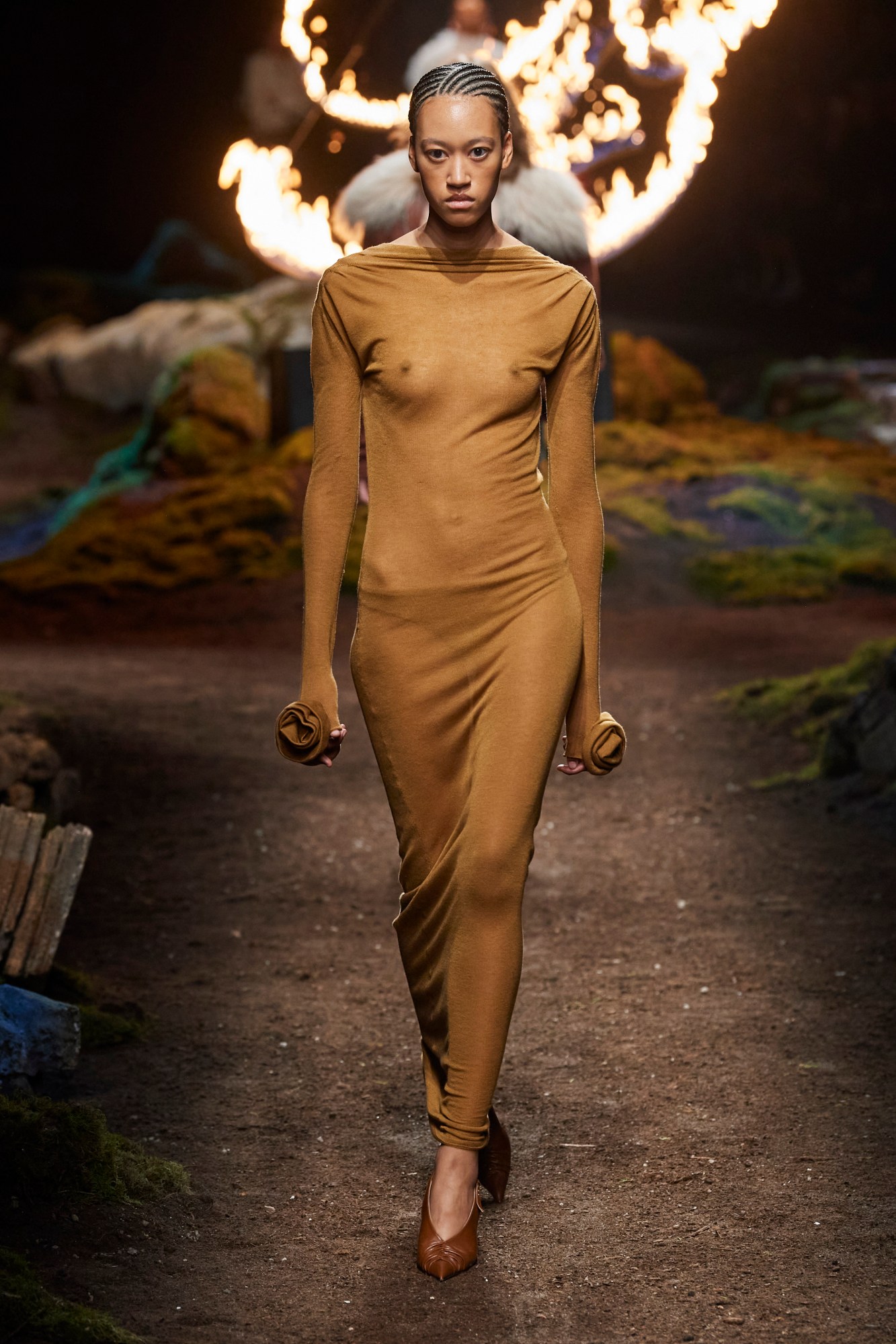

Blumarine
Blazing at the back of the runway of the Blumarine show was the popular Italian fashion house’s insignia alight in flames like a religious symbol. Fitting really, given the cult-like love of the Y2K fashion girlies dying for pieces from both the house’s new and vintage offerings. But the theme behind the show’s aesthetics was women going to battle, “a modern day Joan of Arc” as the show notes read. Skintight dresses and miniskirts had a metallic gleen to them, as if a blacksmith had melted down gold and silver and then poured it over their bodies. The Blumarine women had their armour too, from sexy sheer chainmail maxi dresses to aggressively studded leather gloves, belts and chokers in a warning red and earthy brown, and thick shaggy vests like the kind associated with a biblical warrior. For those worried the house has switched out the early 00s aesthetics for Old Testament aesthetics need not worry though – stringy vest tops were adorned with rows of protective belted straps, baggy cargo pants and chaps were stuffed into knee-high heeled boots, frilly mini dresses had ribbons of fabric hanging off like they’d been through the wars, and flared trousers were suitably low rise. These were clothes for the girls, gays and theys ready to fight but not willing to hide their midriff while doing so. And why should they. TG
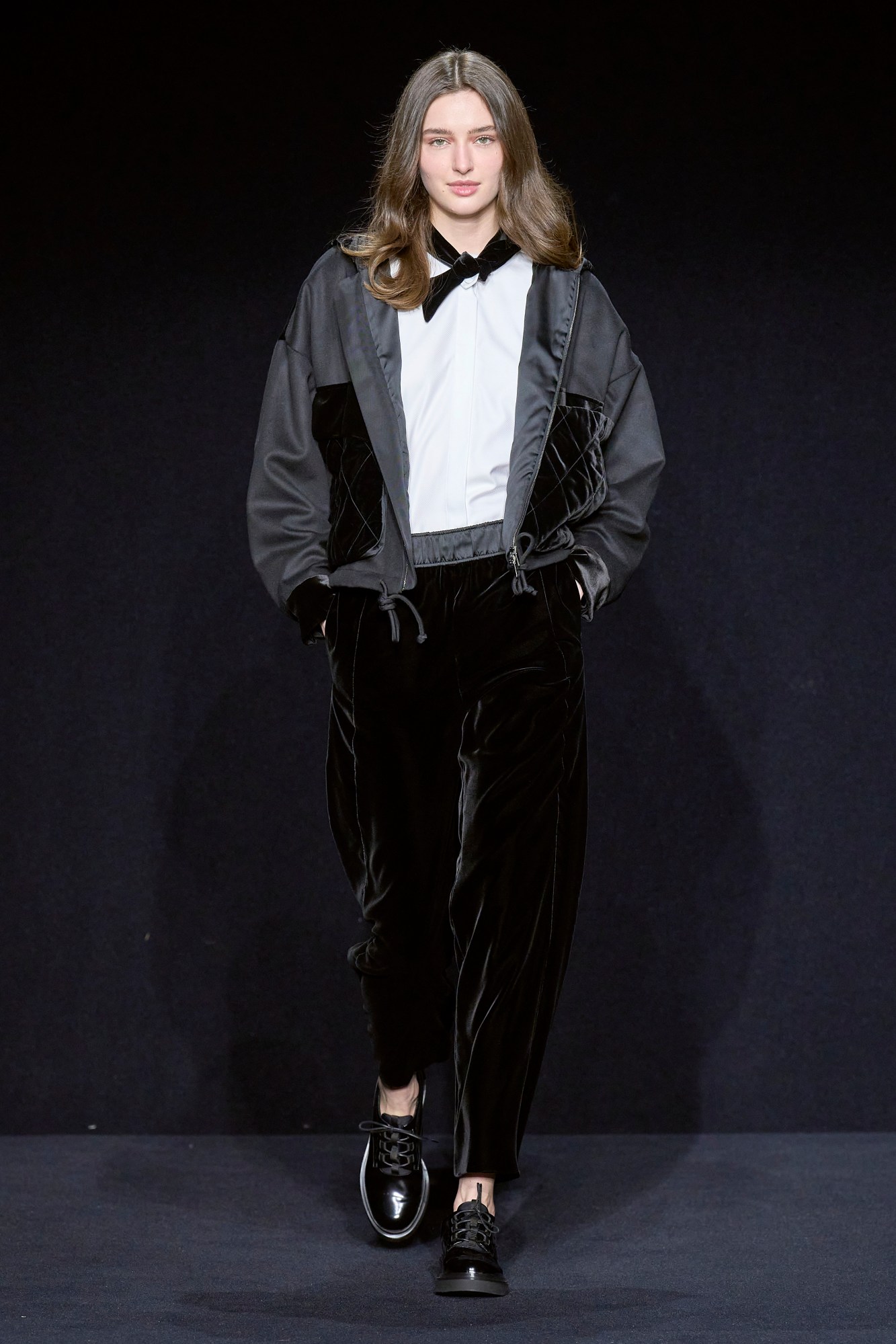
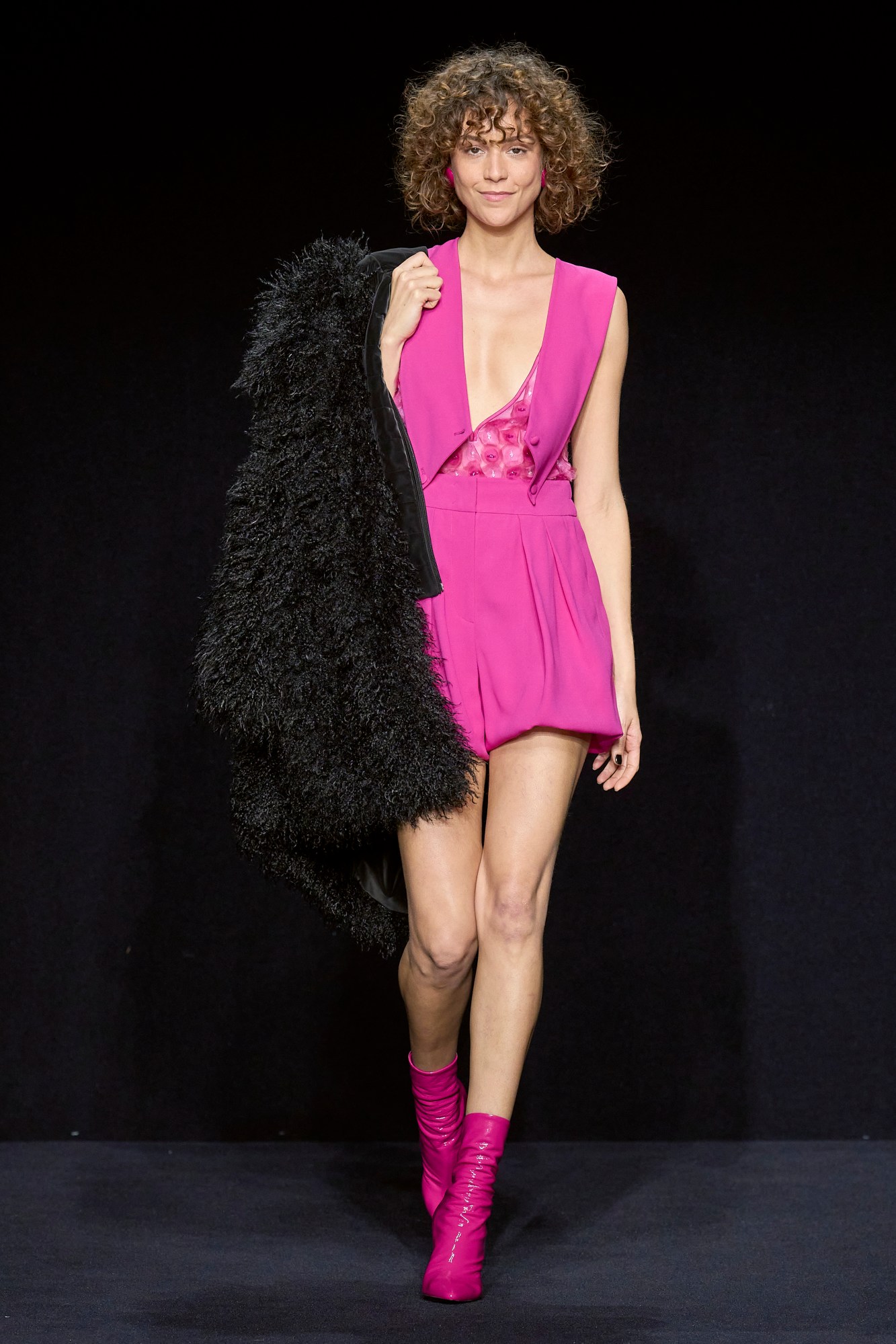
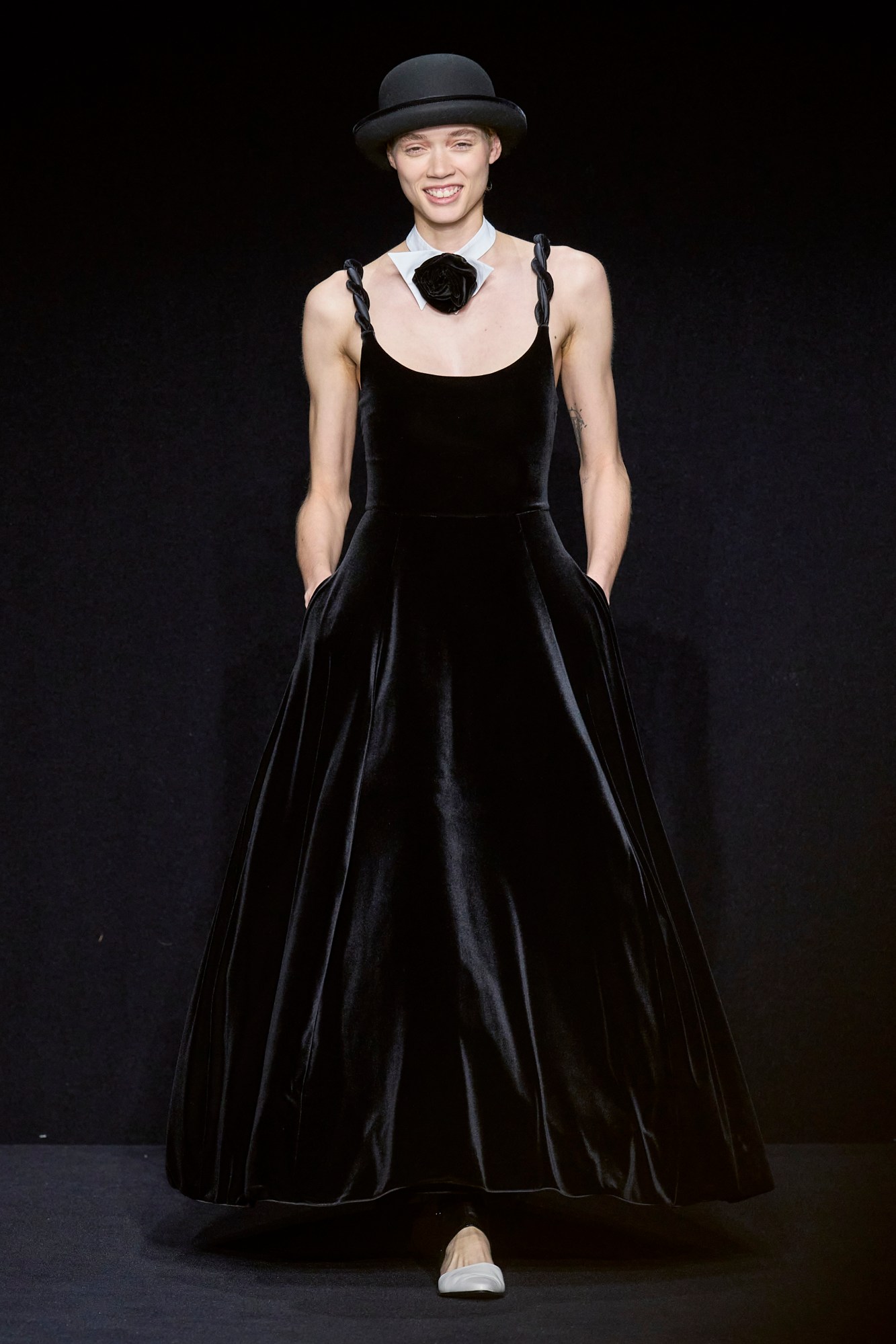
Emporio Armani
A welcoming surprise came down the runway of Emporio Armani’s AW23 show: models grinning from ear to ear, wearing a collection that seemingly had no motives other than to entertain, much like the theatre. Coming out from under a looming 90s-esque portrait of a model with black out sunglasses and a beaming smile, models circled a ring runway wearing whimsical pieces that included floral print coats, and cropped double-breasted velvet jackets with asymmetrical buttoning; hyper-oversized floral necklaces and flowing trousers in shimmering satins reminiscent of stage curtains. Amongst the black, charcoal and marl hues often found within a Giorgio Armani designed collection was hits of bold and bright Barbie pink and crossbody bags had y2k-esque Bratz-doll sized handbag charms hanging off them. That sense of whimsy was then underscored by the small, Charlie Chaplin-esque bowler hats adorning the top of many of the looks. When so much in the world right now is stressfully serious, Emporio Armani decided just to simply put on a fun, innocent show. TG

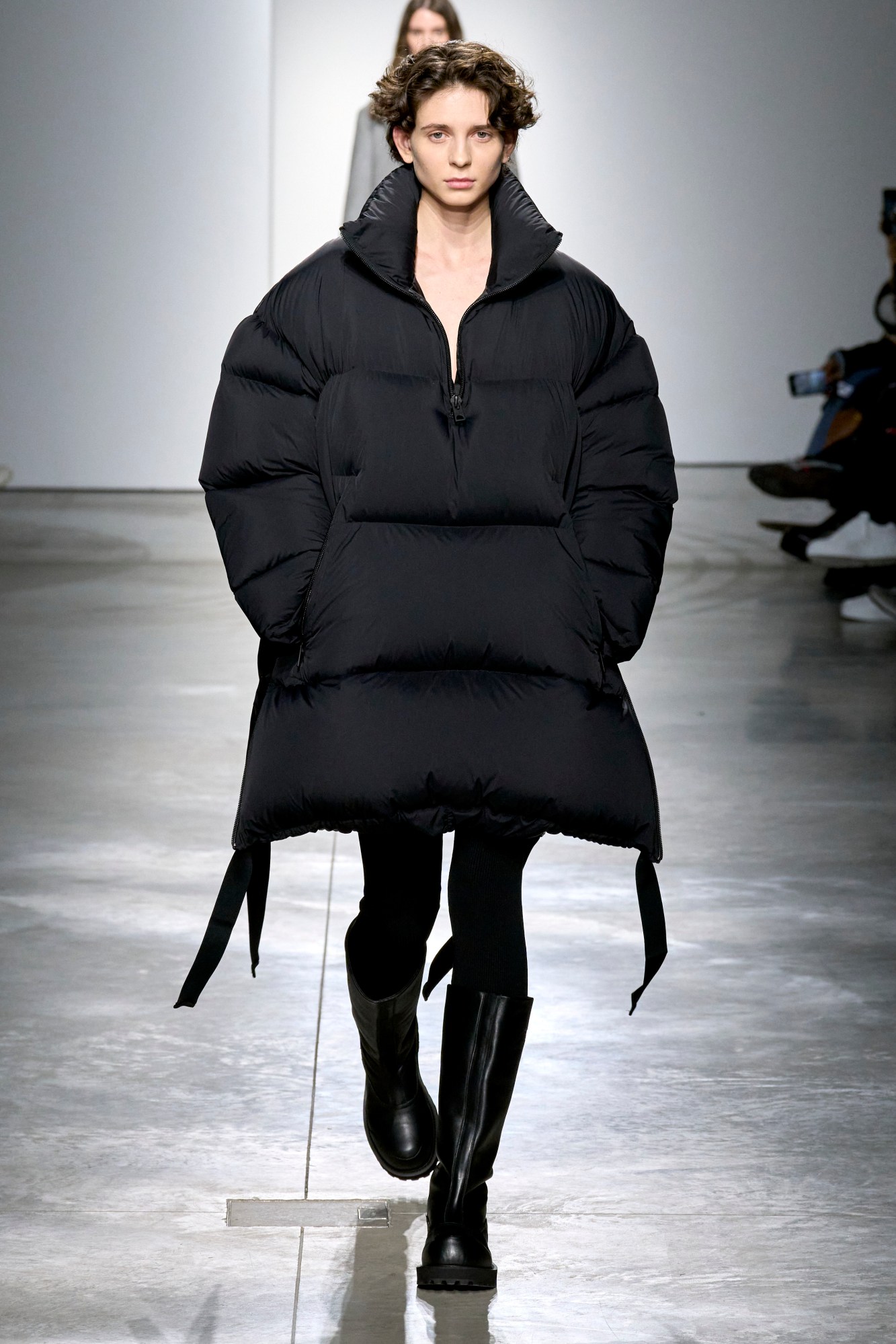
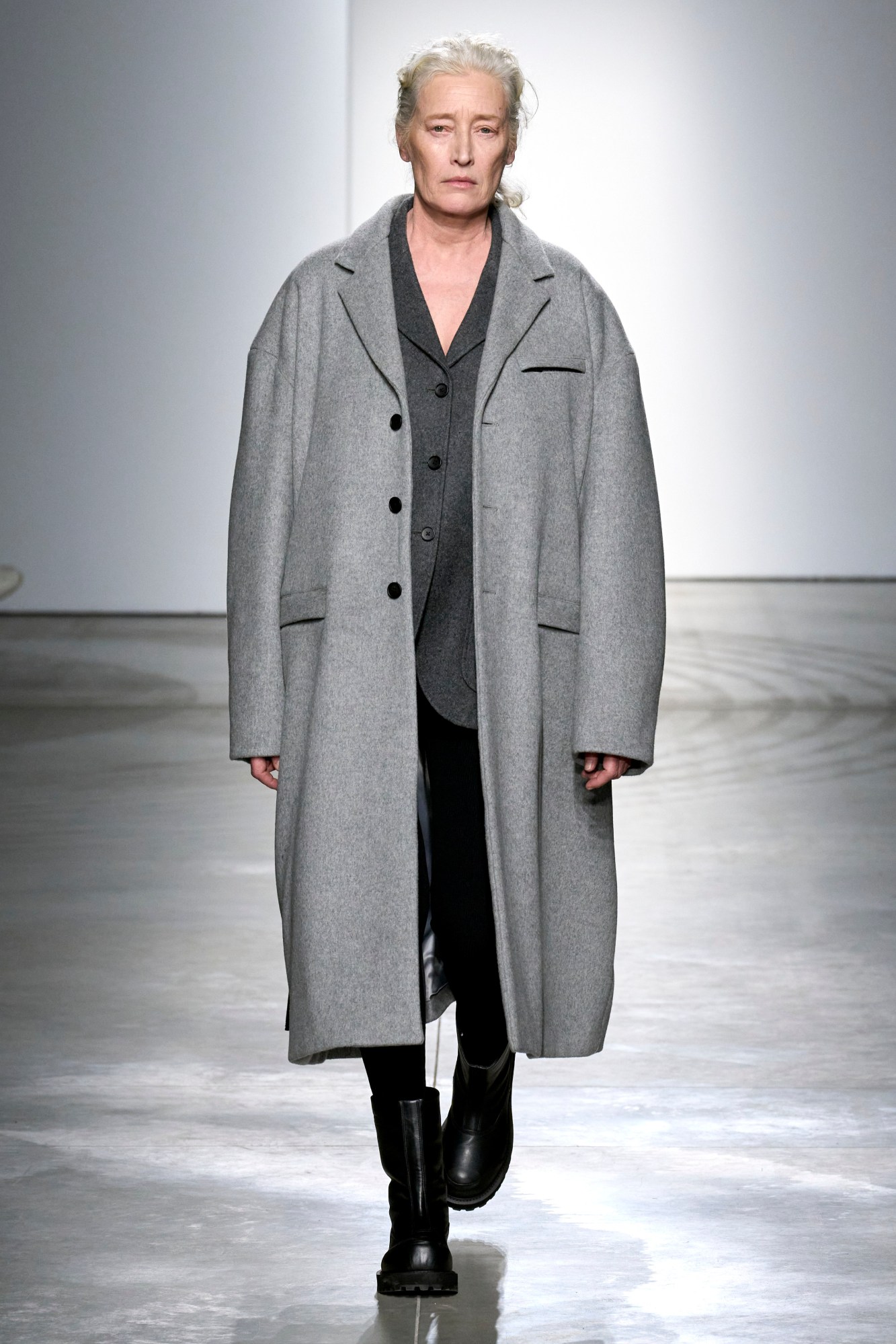
Onitsuka Tiger
Since its runway revamp back in AW23, when it first made its mark on the Milan Fashion Week schedule, Japanese megabrand Onitsuka Tiger has presented collections that meld its sporting heritage with a street-y aesthetic, presenting clothes that embody an expected dynamism from a brand best known for sporty footwear and apparel. This season, though that spirit remained intact, there was a notable shift in tone, with creative director Andrea Pompilio opting to explore more explicitly sartorial territory. Drawing on the Japanese proclivity for layering, textures were cleverly juxtaposed, with gossamer negligée-like dresses and second-skin leggings sitting close to the body, with silhouettes building out to boxy quilted shorts and bombers – created in collaboration with Japanese down-wear pioneer Zanter – and eventually to hulking puffers, broad-shouldered melton wool greatcoats, and boxy wool blazer. With the latter two pieces marking a confident expansion into tailoring for the brand, this collection certainly whetted appetites for whatever Andrea and team have up their sleeves next. MS
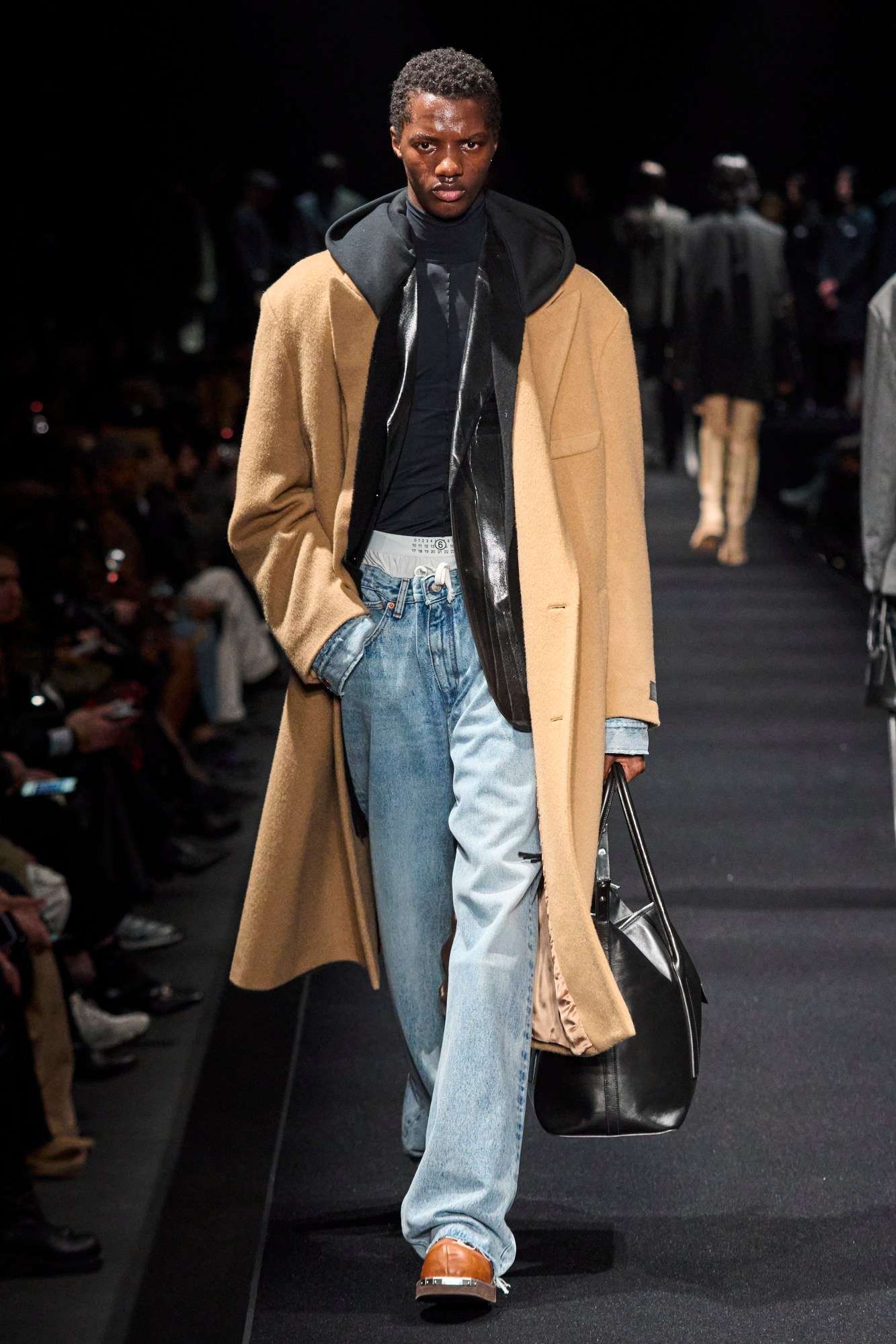
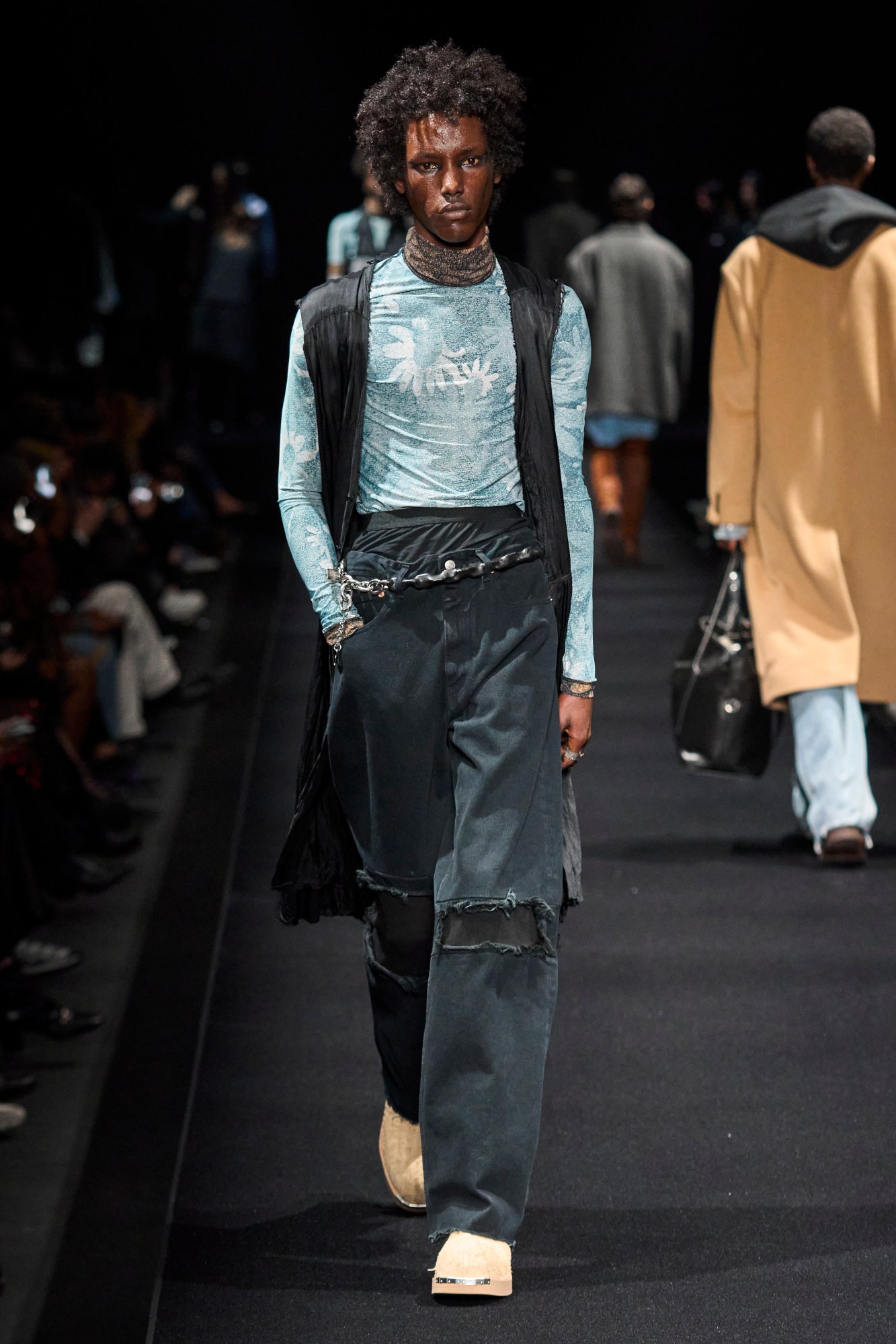
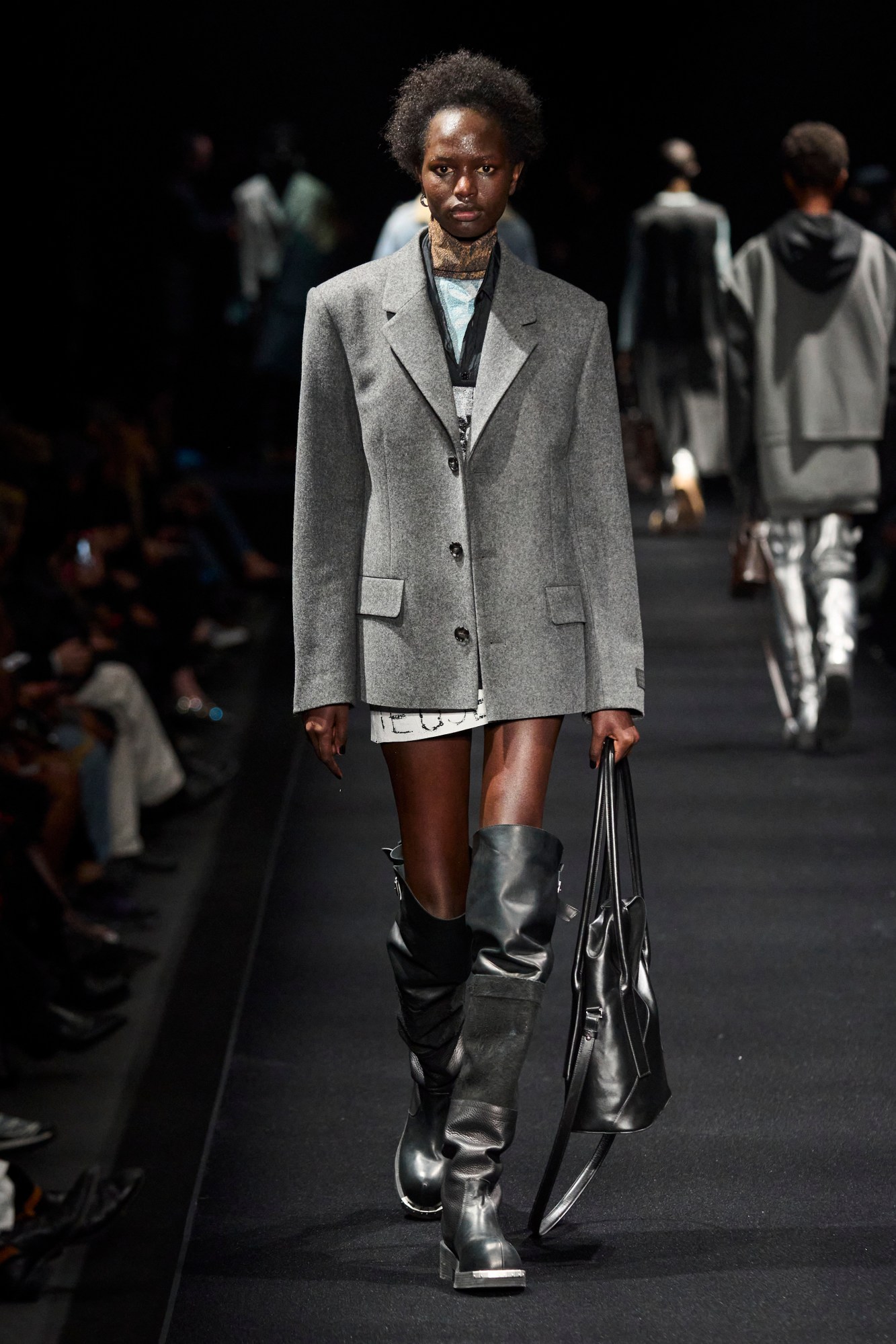
MM6 Maison Margiela
Seasoned Milan Fashion Week attendees know that, going to an MM6 Maison Margiela show, what you expect to see is probably the opposite of what you’ll get. That’s not to say that the brand is intentionally antagonistic with the collections that it proposes, but rather that you’re invariably bound to see something that confounds. See something that tricks the eye into seeing things differently from what they actually are. This season was no different, with the brand’s anonymous design team working on clothes – and whole looks – that explored the notion of trompe l’oeil from a 360 perspective. They created pieces that either spliced together an unexpected sartorial register – say, a fluttering navy satin shirt that came with bulky leather sleeves, and wool tailorings tacked onto a fused jersey hoody – or that created the illusion of layered garments that, on closer inspection, didn’t even exist: a leather gilet that opened to reveal the deceptive plackets on a padded hiking vest and a sharp waistcoat as a case in point.
Indeed, trying to figure out which pieces were these nifty, ersatz hybrids and which were clever tricks of styling was the name of the game here. But that attempt to unpick the puzzle hand is perhaps what made it such an engaging show. At a time when so much fashion is created to be read at the first degree, this was a body of work that invited viewers to think about the relationships between surfaces and the realities they conceal (very apt for current times!) – and, on a more essential level – to really engage with the sartorial jigsaw puzzles they saw before them. These weren’t, however, clothes overladen with cerebral intention, however – with most of the clothes on show nodding to familiar garment archetypes, these were jigsaw pieces that you could easily lift off the rack and slot into the puzzle of your own wardrobe at home. MS
Prada
Miuccia Prada and Raf Simons’ Prada AW23 show in Milan began with a simple gesture of showmanship. Held in the cavernous Deposito of the Fondazione Prada, the showspace was pared right back down to its poured concrete walls. The sunken roof of plasterboard, low and cavernous, slowly began to rise, revealing industrial-orange pillars wrapped in bouquets of white lilies, the scent of which filled the room as the first models emerged. You know that phrase about giving someone their flowers? The architectural trick set the tone for a Prada collection that was all about giving the world’s everyday heroes — nurses, teachers, soldiers, labourers, cleaners; the women who make the world go round, often unnoticed — their literal and figurative flowers. The official title of the collection was Taking Care. Read the full review here. OA
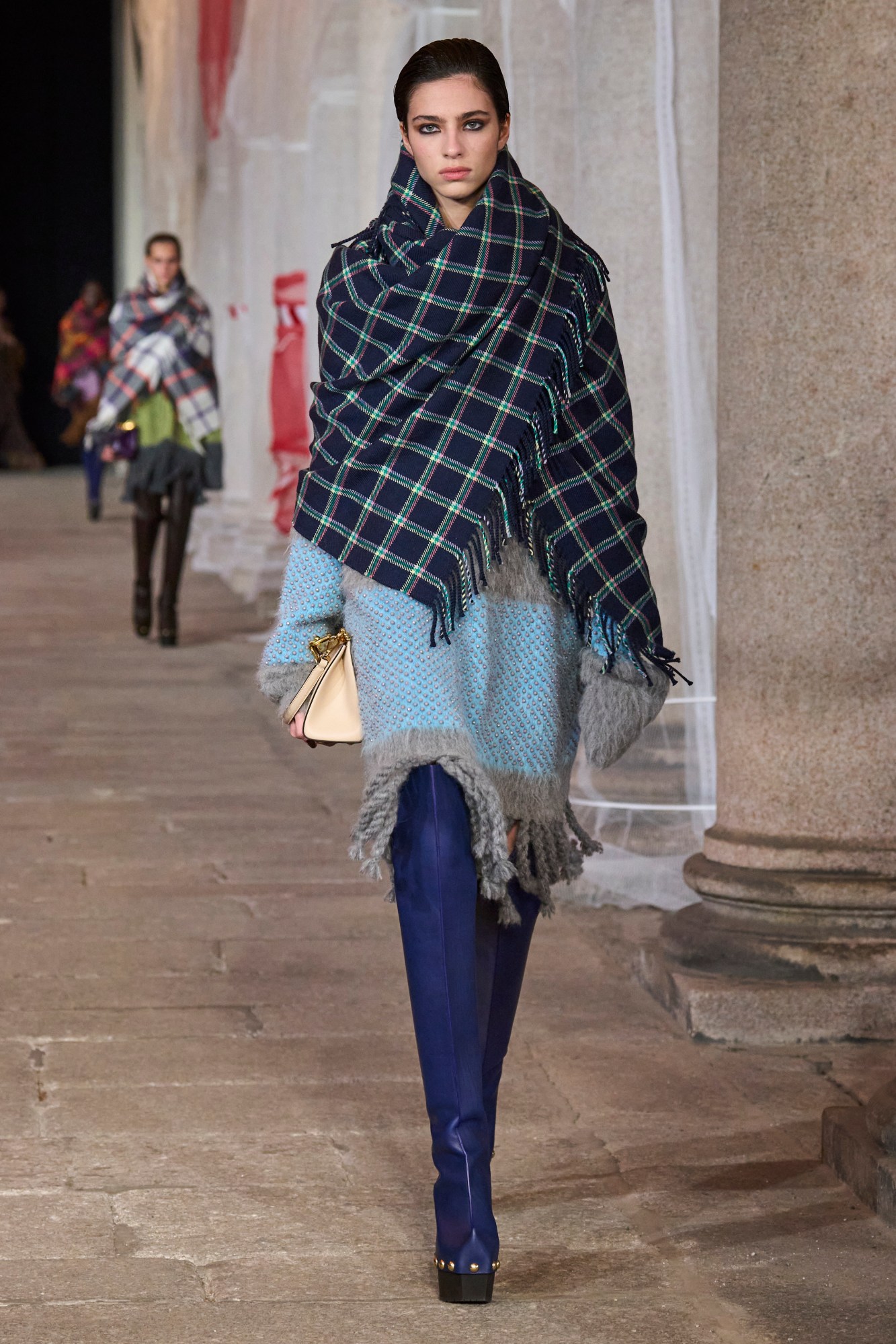
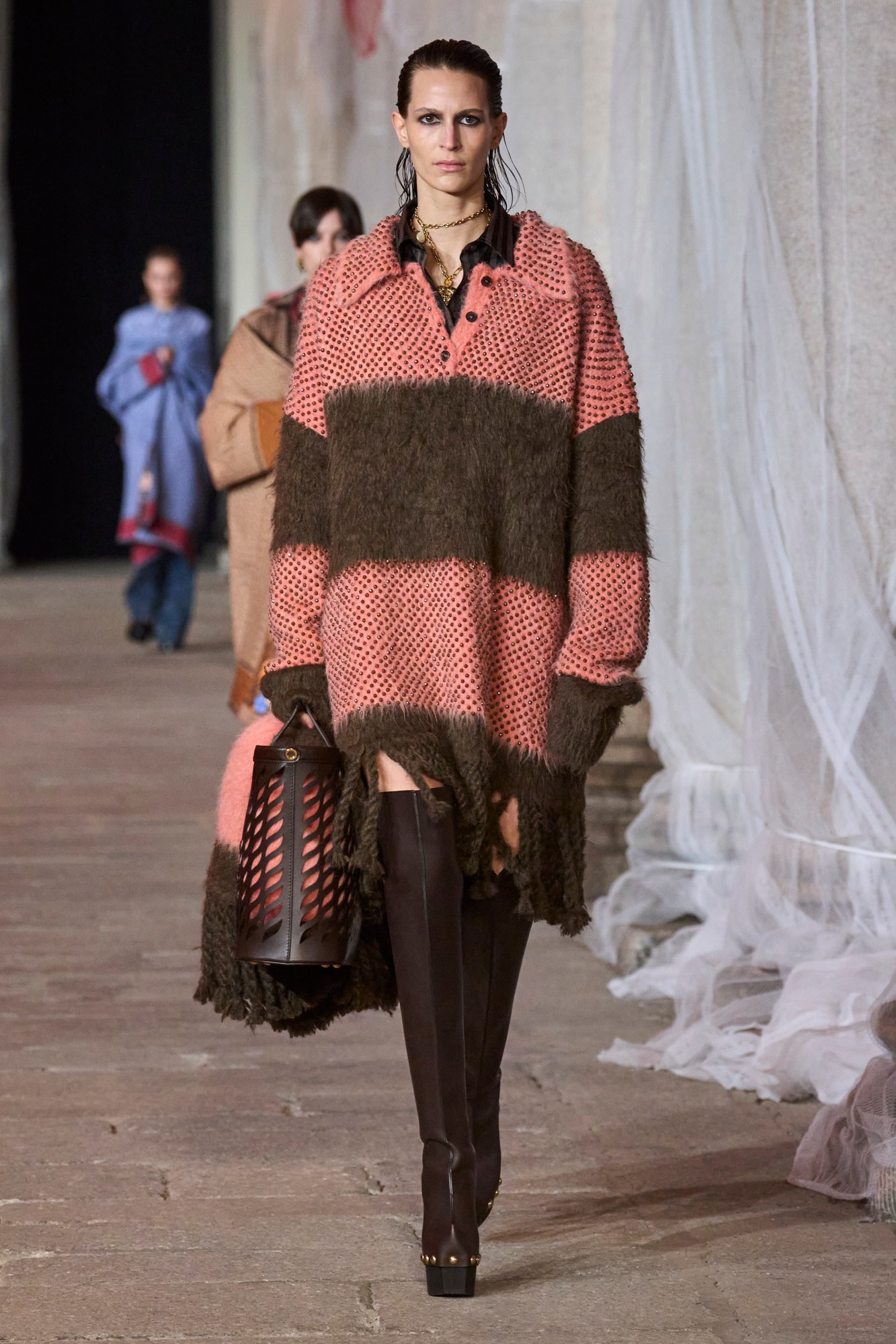
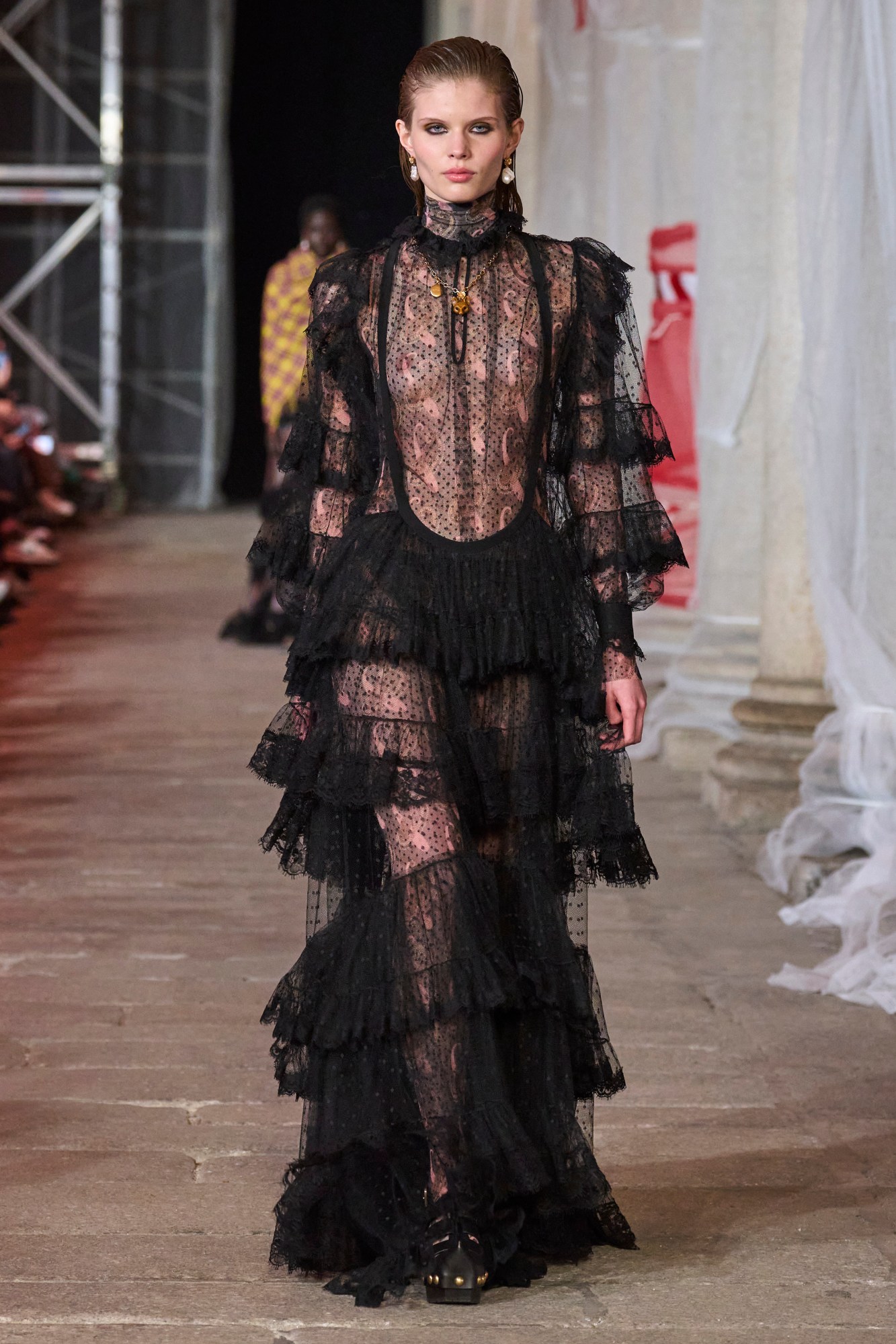
Etro
Wowing with a debut is one thing – appetite and intrigue for a house’s new era is usually high enough that you can get away with a fair few shortcomings – but doing so for a sophomore collection is another entirely. That was the task Marco de Vincenzo faced yesterday in Milan, presenting his second collection at the helm of Etro. Taking to a crumbling palazzo currently under renovation, the setting served as an apt metaphor for the approach he’s taken to his role – an almost archaeological rediscovery of the house’s time-honoured code. The results of this excavation led him to pursue a radical interpretation of Etro – though not in the contemporary sense of irreverence and rebellion, as you’d perhaps expect. Rather, his Etro more faithfully echoes the Late Latin roots of the term, radicalis, which means, well, roots. Accordingly, what we saw amounted to a respectful yet innovative revival of its signature paisleys, printed all-over on tumbling silk crepe gowns, poppy tartan wool shawls, and billowing floral prints. Off-setting the flutter and frou-frou of this season’s dresses and blouses was hourglass tailoring embroidered with polka dots and paisley swirls, as well as cloche-silhouette coats with scooping necklines in earthen tweeds and pastel wools. All in all, a promising harbinger for a bright period ahead for the house. MS



Del Core
If Daniel Del Core’s previous collection was inspired by ‘liquidity’ and the sea, AW23 brought the Milan-based designer back on land, celebrating a fresh world risen from the ashes. “Recently, on a hiking trip to the Gate of the Arctic in Alaska, I was struck by the power of fire in the wilderness. Fire is often misunderstood, viewed only as a destructive force,” Daniel shared in his show notes. “However, as I walked through the deep fabric of moss and lichen and witnessed the regeneration set by the flames, I was reminded that beauty can arise from destruction.” This became the inspiration behind burnt orange and umber print – inspired by a fungus he found on rocks in the Alaskan national park entitled Sunburst Lichen – growing up sheer dresses, suiting and puffer coats with elegant droop shoulders then cinched by cross-chest leather belts. Sheer fabric was layered to resemble bark and either charcoal black or as beige as a freshly revealed inside of a tree, were twisted into fitted high-slit gowns that became increasingly diaphanous as the material tumbled down the leg. Elsewhere, fluffy trench coats were either in a burnt moss green, or had peaks of ashy black growing from the hem resembling an abstract landscape photo of a freshly fire-hit forest. Gowns and tailored tops and jackets were slit at shoulders, knees and elbows and then attached by a single button, like a disintegrated tree branch barely holding on to its burned down trunk. Daniel once again proved his unique way of seeing the natural world, its power and beauty, and turning that into an exploration of gorgeously feminine evening wear. TG



Diesel
Since taking the reins at Diesel, Glenn Martens tenure at the Italian megabrand has been marked by wanton sexiness and fun. This season, those values were indeed at the heart of the collection he presented, but it would seem that he’s as keen on ensuring that we all have as much sexy fun out of his playfully experimental clothes as we do wearing them. That’s what we got from this season, anyway, a Diesel-branded box of Durex condoms, 200,000 of which formed a gigantic mound at the centre of the show venue. “Sex positivity is something amazing,” Glenn said of the intention behind the gesture. “We like to play at Diesel, and we are serious about it. Have fun, respect each other, be safe. For Sucsexful Living!”
The clothes themselves – which featured a preview of forthcoming collaboration with the global condom manufacturer – were indeed the sort of thing that we could see ourselves wearing for sucsexful living. Denim was naturally top of the agenda, with ultra-low rise jeans dipping below hip bones as if it were 2003 all over again. Elsewhere floor length skirts, boxy shirts and crystal-strewn long-sleeved dresses were crafted in the designer’s now signature denim devoré, offering flashes of the wearer’s flesh beneath, their sheerness counterposed by chubby puffers and floor-trailing greatcoats in shredded denim treatments. Hoodies came in cobweb jerseys, while cocktail dresses, and bandeau top and skirt combos were draped from scrims of pearlescent satin. Perhaps not the most practical clothing for the winter ahead, but when was dressing sexy ever about practicality? Indeed, this was a kit to dress up when you’re undressed (by a consenting partner, of course) at the end of the night. MS
